Ready to make a guinea pig lover’s Christmas extra special? You’re in the right place. Celebrate the joy these adorable pets bring by finding a gift that shows how much you care. Whether you’re shopping for your own guinea pigs or for someone who adores theirs, you’ll discover ways to make the holiday season even brighter. Thoughtful gifts can help create lasting memories and show appreciation for the unique bond between guinea pigs and their humans.
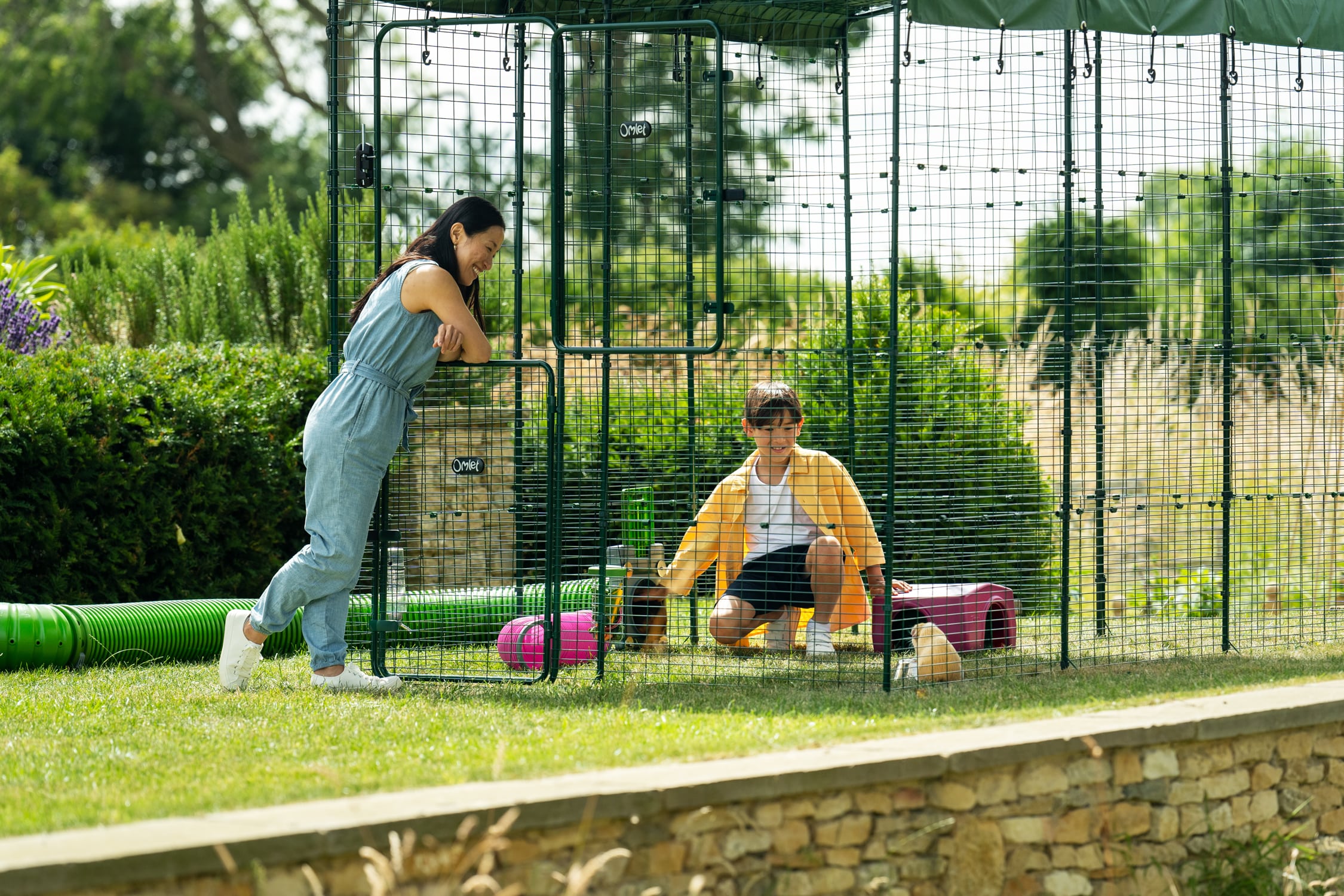
Guinea Pig Accessories
Caddi Guinea Pig Treat Holder
Support your guinea pigs’ well-being with the Caddi Guinea Pig Treat Holder from Omlet. This thoughtfully designed feeder keeps fresh fruits and vegetables off the ground, helping maintain a cleaner habitat and reducing food waste. By suspending treats, the Caddi also discourages pests and encourages your guinea pigs to engage in natural foraging behaviors, providing both mental and physical stimulation. It can even be used as a hay feeder, making it a practical addition to any guinea pig enclosure.
Your guinea pigs will enjoy the interactive experience of retrieving their snacks from the swinging holder, turning feeding time into a stimulating activity. The adjustable nylon string and sturdy plastic hook make it simple to hang the Caddi in any run or enclosure, including Omlet’s Outdoor Guinea Pig Run. If you’re looking to enrich your guinea pigs’ environment and streamline feeding, this treat holder is a smart choice for your holiday list.
Zippi Guinea Pig Shelter
Give your guinea pigs a safe and inviting space with the Zippi Guinea Pig Shelter. Designed to be a fun hideout for your guinea pigs, this shelter offers a secure spot where your pets can relax and feel at ease. Its robust construction also allows guinea pigs to climb on top and observe their surroundings, supporting their natural instincts.
The Zippi Shelter fits seamlessly into the Zippi Guinea Pig Run and Playpen, but it’s also compatible with the Eglu Go Hutch and Outdoor Guinea Pig Run. With two entrances, your guinea pigs can move freely, encouraging exploration and interaction. This shelter is a versatile accessory that helps create a comfortable and engaging environment for your pets.
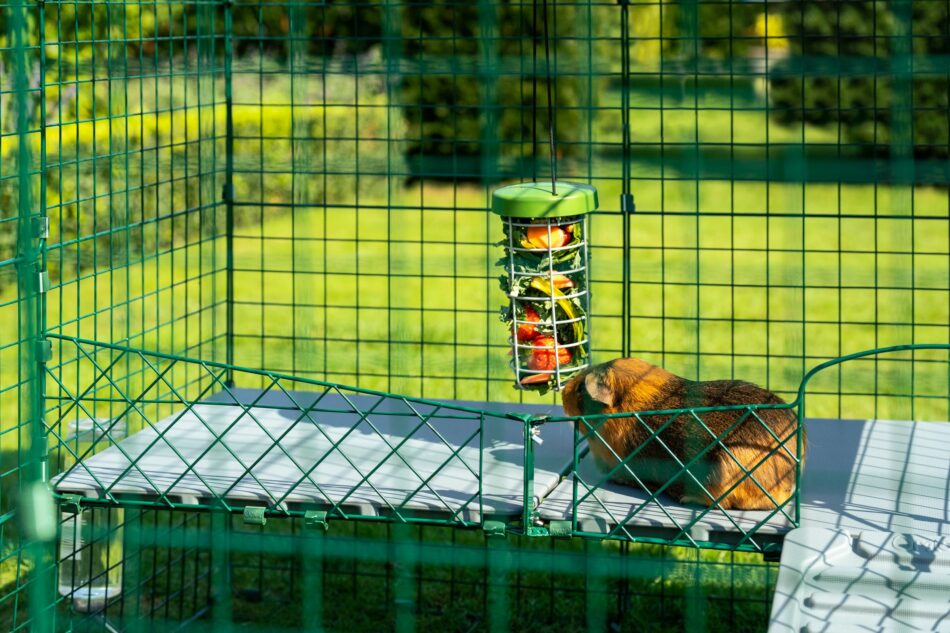
Guinea Pig Playpens and Runs
Zippi Guinea Pig Playpen
The Zippi Guinea Pig Playpen from Omlet is designed to offer your pets a secure and flexible space for exercise and interaction. Its open design makes it easy for you and your family to spend time with your guinea pigs while keeping them safe. The playpen is fully compatible with the Zippi Tunnel system, allowing you to expand and customize your setup as needed.
The starter pack includes secure mesh panels and run clips, which can be arranged to fit your available space. One panel folds down for convenient access, and a dedicated portal allows for easy tunnel connection. Optional extras like mesh roofing, extension panels, and covers are available, so you can adapt the playpen to suit your needs. This setup is ideal for supervised play, giving your guinea pigs a safe area to explore.
Zippi Guinea Pig Tunnel System
The Zippi Guinea Pig Tunnel System by Omlet offers a creative way to connect your hutch to a larger enclosure, giving your pets more room to explore. The modular tunnels can be expanded and reconfigured, allowing you to design a layout that fits your space and your guinea pigs’ needs. The spacious tubes accommodate all breeds, and the secure connectors make it easy to add corners, junctions, and look-outs for added enrichment. The Zippi system is compatible with a variety of hutches and runs, including wooden hutches and the Eglu Go Guinea Pig Hutch.
This tunnel system is designed with both pets and families in mind, featuring secure locking mechanisms and optional lockable doors for added safety. Accessories like hay stations and support hoops add further functionality, helping you create a stimulating and healthy environment. The Zippi Tunnel System is a practical way to encourage your guinea pigs’ natural behaviors and enhance their daily routine.
Outdoor Guinea Pig Run
Guinea pigs thrive when they have space to move and explore. The Outdoor Guinea Pig Run by Omlet is designed to blend into your backyard while providing a secure and spacious environment. Its extendable design allows you to adjust the size and shape to suit your needs, making it suitable for all breeds. You can connect it to your Eglu Go Guinea Pig Hutch, place a wooden hutch inside, or use it as a standalone play area.
Available in two heights, the High-Rise version allows you to walk in for easy interaction and cleaning, while the Low-Rise version offers a generous floor area at a lower height. Both options feature easy-access doors and are suitable for all breeds. The run can be accessorized with covers to provide shelter from the weather, ensuring your guinea pigs are comfortable throughout the year. With flexible options and thoughtful features, this run is a valuable addition to any guinea pig setup.
Guinea Pig Hutches
Eglu Go Plastic Guinea Pig Hutch
The Eglu Go Guinea Pig Hutch offers a practical and stylish solution for keeping your pets safe and comfortable outdoors. Its durable plastic structure provides insulation for year-round comfort and is easy to clean, while the secure run keeps your guinea pigs protected. The hutch features two main areas: a cozy space for resting and eating, and a run for exercise and exploration.
Maintaining the Eglu Go Hutch is straightforward, thanks to its wipe-clean surfaces and slide-out bedding tray. The run includes an anti-tunnel skirt to prevent digging, and its green finish blends into any garden. You can easily connect the hutch to the Zippi Tunnel System, giving your guinea pigs even more space to enjoy.
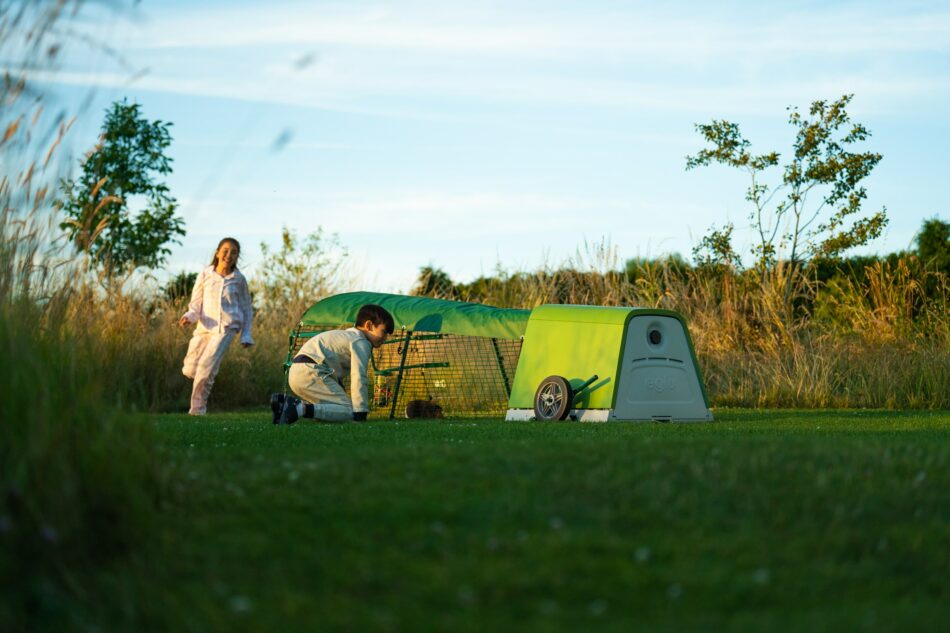
Omlet and Your Guinea Pig
Choosing the right accessories can make a meaningful difference in your guinea pigs’ happiness and well-being. Whether you’re updating their living space or adding practical features, each product on this gift list is designed to support your pets’ comfort and enrichment. This holiday season, you can feel confident that you’re giving your guinea pigs the best care possible.
This entry was posted in Christmas
Guinea pigs may be small, but they have big appetites. These little foodies enjoy a variety of offerings, but what can guinea pigs eat? The right balance in their diet helps them stay healthy and happy, and from their teeth to their tummies, they’re designed to be digesting machines with the right foods. Here’s a look at what you should (and shouldn’t) be feeding your guinea pigs.
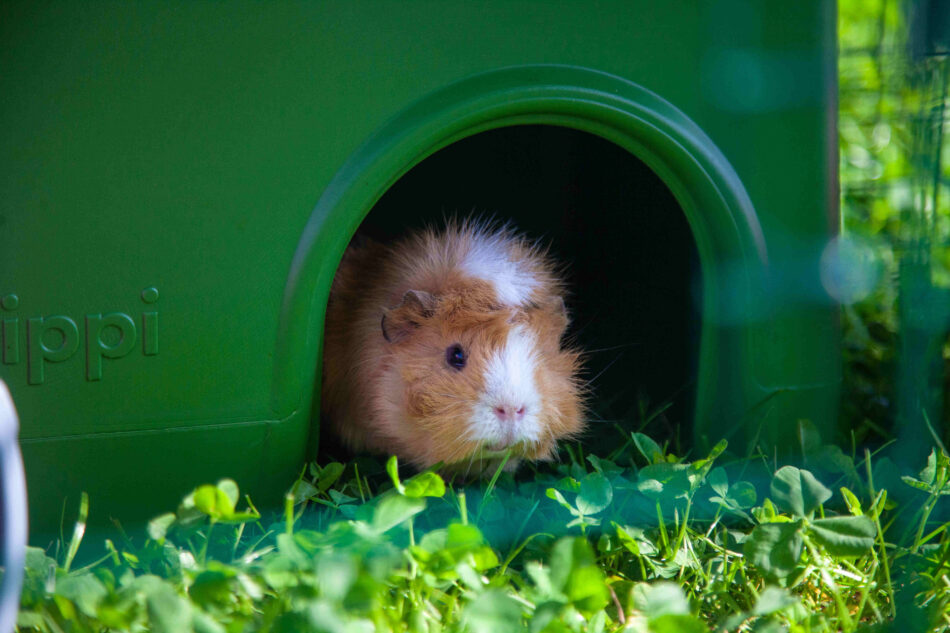
Guinea pig anatomy
To understand what guinea pigs can eat, you have to get familiar with their anatomy, and the foods you offer them should support their unique physiological needs. There a few quirks to the inner workings of guinea pigs:
- They’re rodents, so their teeth never stop growing.
- Their digestive system is built to process lots of fiber, which is essential to keep everything moving smoothly.
- Unlike many other mammals, guinea pigs can’t make their own vitamin C, so they need it from their daily diet.
With these in mind, you’re ready to start meal planning for your guinea pigs.
The ideal guinea pig diet
Cavy cuisine doesn’t have to be complicated. Creating the right balance for your guinea pigs will support healthy metabolisms, body composition, and immune systems. Here’s what your guinea pig meal planning should look like:
- Hay (about 80%) — Unlimited fresh hay should be the foundation of your guinea pigs’ diet. Timothy or orchard grass hays are excellent choices, and when offered free-choice, will help wear down their ever-growing teeth and promote healthy digestion.
- Fresh vegetables (10-15%) — Leafy greens like romaine lettuce, bell peppers, and cilantro provide vitamins and hydration.
- Pellets (5-10%) — Choose guinea pig-specific pellets that have been fortified with vitamin C. Avoid the “trail mix” variety with artificially colored pieces or with nuts and seeds mixed in, as cavies will pick out their favorite pieces and leave the more nutritious bits behind.
- Fresh water (always available) — Clean water is just as essential as food. Make sure your guinea pigs have constant access to water to ensure they’re adequately hydrated.
In addition to these dietary staples, guinea pigs can benefit from a variety of treats — in moderation.
Supplemental foods to incorporate
Guinea pigs have a diverse palette, and can enjoy a number of fresh foods when offered sparingly. Because of their endearing potato-like build, cavies are prone to obesity, so treats should be given only occasionally and introduced in small portions to avoid digestive upset. And, when you do treat your guinea pigs, they should be safe and nutritional offerings.
Leafy greens like romaine lettuce, kale, or herbs like parsley and cilantro make great treats that pack a nutritious punch. Spinach is another good option, but should be given in moderation because of its oxalate content.
Vegetables are great additions to their diet, but not all veggies are created equally for cavies. Bell peppers, cucumbers, and zucchini are the best varieties, with the occasional carrot or sweet potato tossed in. It’s best to offer vegetables to your guinea pigs in a treat holder to reduce waste and promote slower eating.
Fruits are a little trickier for guinea pigs. They love them, and they offer nutrients, but their sugar content can cause cavies to become overweight more easily than other treats. Stick to small portions of apple slices, blueberries, or seedless orange slices no more than a couple of times a week.
What about store bought snacks?
Commercially produced guinea pig snacks can be offered, but choose them carefully, paying special attention to their ingredients. Just like convenience snacks for humans, store bought cavy treats are often full of sugar and lack much nutritional value. Look for no added sugars or seeds, and avoid artificial dyes or preservatives.
Safe vs. unsafe guinea pig food list
Because most guinea pigs will happily indulge in whatever food they’re offered, it’s important to know what is safe and what is unsafe for them. Here’s a quick list to consult before offering your cavy a snack:
Safe guinea pig foods to offer in moderation:
- Leafy greens — romaine lettuce, kale, spinach (in moderation), dandelion greens, and arugula.
- Herbs — parsley, cilantro, mint, basil, oregano, and dill.
- Vegetables — bell peppers (red, yellow, and green), cucumber, zucchini, carrots (as an occasional treat), broccoli, and celery (cut small to avoid strings).
- Fruits — apple (seeds removed), blueberries, strawberries, melon, pear, and orange segments.
- Other — small amounts of pumpkin or squash, and flower petals from marigolds, roses, or calendula.
Unsafe guinea pig foods to avoid completely:
- Toxic plants and vegetables — onion, garlic, chives, leeks, rhubarb, potatoes (excluding sweet potatoes), tomato leaves and stems.
- Fruits with risks — avocado (toxic), grapes and raisins (linked to kidney issues), cherries and stone fruits (pits are dangerous).
- Sugary or processed foods — bread, crackers, cereal, chocolate, or candy.
- Animal products — meat, dairy, or eggs.
- Other hazards — lawn clippings (can ferment and cause stomach upset) and house plants (many are toxic).
Dietary red flags to watch out for
Being in tune with your guinea pig will alert you if something is not right. Perform routine health checks on your guinea pigs and monitor their behavior and appearance to see if anything is amiss with their diet. Signs of dietary issues include:
- Weight loss or sudden changes in appetite
- Diarrhea or very soft droppings
- Overgrown teeth or drooling
- Dull coat or flaky skin
- Lethargy or lack of interest in food
If you notice any of these, it’s a sign that they aren’t getting all the nutrients they need. Schedule a visit with your veterinarian to address any other underlying issues, and to tweak your cavies’ diet to promote their overall health.
Omlet and your guinea pigs
Feeding your guinea pig is just part of their care. At Omlet, we believe in creating a supportive environment for you and your cavies without complicating things. Our Eglu Go Guinea Pig Hutch, Zippi Playpens and Runs, and Zippi Tunnel System all encourage the natural behaviors of guinea pigs while keeping them safe and comfortable in any season. With a balanced diet and an ideal home, your guinea pigs will be able to live a long, happy life with you.
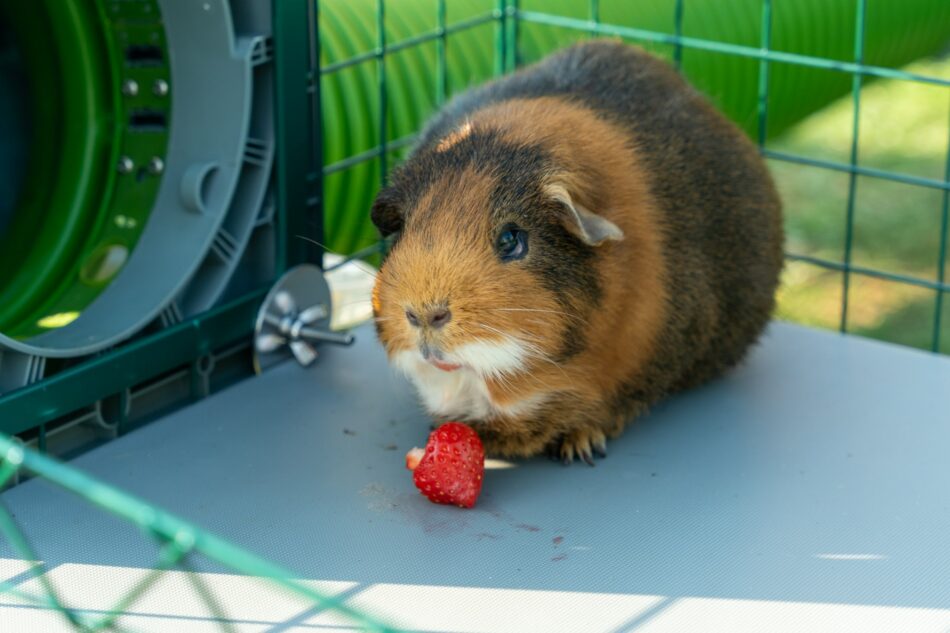

This entry was posted in Guinea Pigs
If you share your yard or garden with rabbits or guinea pigs, you’ve probably noticed their affinity for digging, dashing, and disappearing into hidey holes. Both bunnies and cavies are designed for movement and exploration, which is why the Zippi Tunnel System is perfect for small pets. Thoughtfully engineered to mirror the way rabbits and guinea pigs behave in the wild while still fitting neatly into your backyard, the Zippi Tunnel System was invented for big fun with small animals.
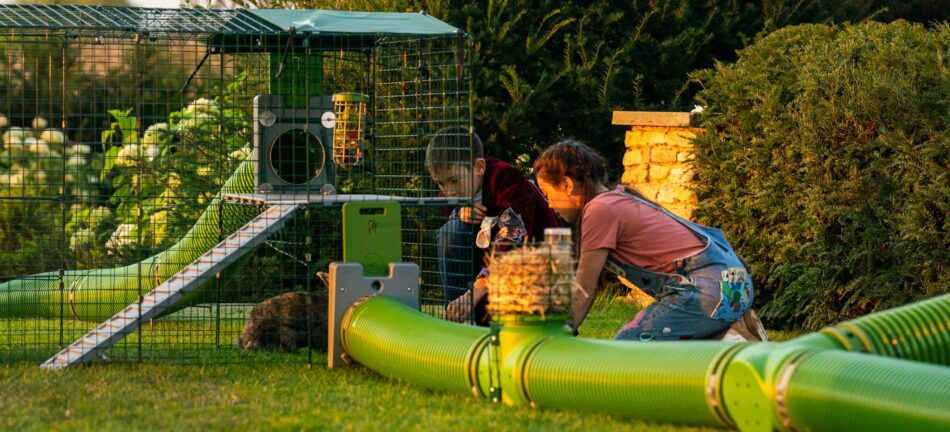
Understanding the need for tunnels
Rabbits and guinea pigs are prey animals by nature, which drives their natural tendency and urge to dig (in the case of rabbits) and burrow. They rely heavily on quick thinking and even quicker movement, seeking the most convenient and concealing hiding spot. Rabbits dig their own burrows that form an extensive network of tunnels and chambers, collectively called a “warren.” Guinea pigs don’t dig, but instead prefer to repurpose abandoned burrows or warrens dug by other animals or carved out by nature. Both bunnies and cavies are wired for these behaviors:
- Foraging: They need variety and movement to find food.
- Exploration: They thrive with novelty and the ability to roam.
- Safety: Instinct pushes them to seek cover whenever they sense danger.
These instincts don’t disappear when rabbits and guinea pigs are domesticated. And if they aren’t able to express and exercise them, it can manifest as boredom, stress, and even destructive behavior.
Why enrichment matters
For small pets, enrichment is more than “nice to have.” To your bunnies and cavies, exciting elements can make all the difference in the world. Creating an engaging and supportive environment for your small pets fosters better mental and physical health, and bolsters bonding opportunities. This is where the Zippi Tunnel System slips in seamlessly – taking natural instincts and translating them into backyard enrichment.
Satisfying instinct through design
The Zippi Tunnel System isn’t just a toy, it’s engineered with bunny and cavy behavior in mind. The tunnels mimic the underground passageways that rabbits naturally excavate while providing guinea pigs with the sheltered routes they crave. Pets can dash, dart, or dawdle at their own pace between their hutch, playpens, or other designated area without waiting on their humans to relocate them.
As Marit, one of our designers behind this system, puts it:
“Gone are the days of stressful moves between the hutch and run – with the Zippi Tunnel System, your rabbits and guinea pigs can easily access different areas of their enclosure at any time. And when combined with Zippi Playpens, you can expand your pets’ world, providing them with fresh grass and opportunities to explore with every turn of the tunnels. The tunnels themselves are made from a blend of LDPE and HDPE, allowing for bends while still maintaining firm stability. The ergonomics ensure good grip, drainage, and ventilation inside the tunnels, and they can be easily separated for quick cleaning. You can disconnect and reconnect the tunnels with just a couple of button clicks on the connection collars, allowing owners of all ages to enjoy creating fresh new setups.”
A system for every setup
The Zippi Tunnel System gives your pets the freedom to roam while keeping them (and your prized plants) safe. Here’s why this system is perfect for any setup:
- Customizable layouts: You can run your pets’ tunnels over, under, or through your garden without digging or trenching.
- Universal, flexible connections: Attach Zippi Tunnels to wooden hutches or mesh runs, or seamlessly integrate them with the Eglu Go Rabbit and Guinea Pig Hutch and any of our small animal outdoor runs.
- Garden-friendly design: Move, rearrange, or expand your system as your space allows without it overtaking your plants or progress.
Owners can appreciate the convenience of not having to chase their rabbits or guinea pigs around or manually relocating them from hutch to run. Instead, simply open the door to a world of endless possibilities.
The materials behind the magic
Small-pet products live or die by the details. That’s why the Zippi Tunnel System is crafted from a carefully chosen blend of LDPE (low-density polyethylene) and HDPE (high-density polyethylene). This combination offers durability for everyday wear and flexibility for creating gentle curves without cracking or collapsing. Our Zippi Tunnels are non-toxic, resistant to rain, and offer a grippy texture for the delicate paws that travel them.
The bigger picture of pet happiness
With the Zippi Tunnel System in place, enrichment becomes part of your pets’ daily rhythm – just as nature intended. They decide when to move, hide, or explore, making their routine richer without requiring more work from yours. And the benefit to owners is just as great, without stressful wrangling or escape attempts. With this infinitely-expanding setup, your pets’ home can grow with them and your experience level. Whether you’re just starting with rabbits or guinea pigs or are a seasoned bunny or piggy parent, you can create a warren worthy of your pets’ praise.
Omlet and your small pets
The Zippi Tunnel System isn’t just a clever invention, it’s part of a bigger philosophy that we bring to all of our products: reimagining life with pets to keep things simpler, safer, and more satisfying for everyone involved. Combine our Zippi Tunnel System with a Zippi Run or Playpen, or connect them to an Eglu Go Hutch to instantly transform your backyard into a secure above-ground burrowing network for your rabbits and guinea pigs. Pets thrive best when their needs are understood and met creatively, and the Zippi Tunnel System delivers just that – turning natural instincts into joyful, everyday enrichment for small pets and the people that love them.
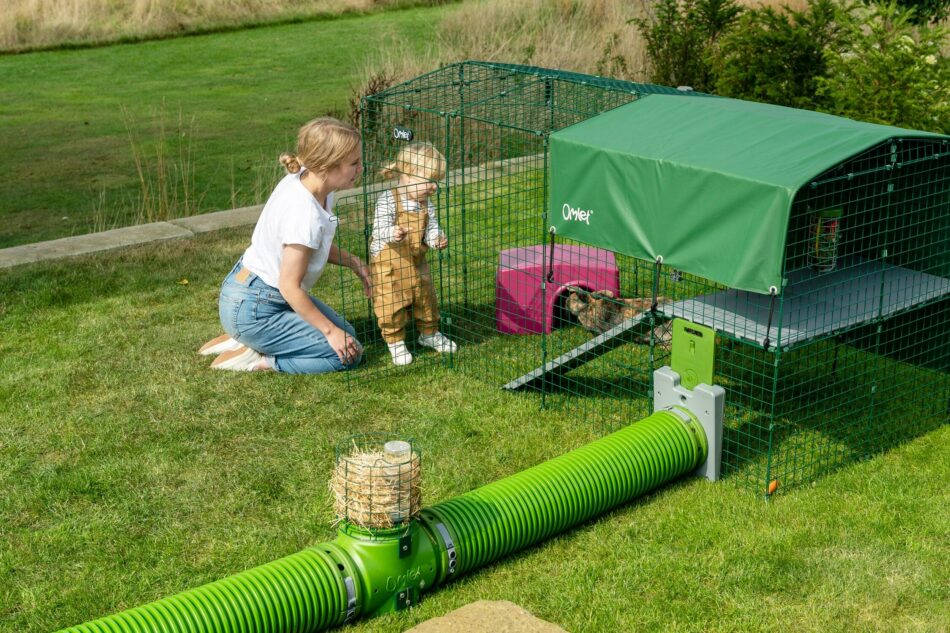

This entry was posted in Guinea Pigs
Wondering how to keep guinea pigs cool in summer? Making adjustments for your guinea pigs, particularly if they’re housed outdoors, is a necessity of the season. Because cavies can’t sweat and have compact bodies with dense fur, keeping them cool during the summer is critical to their survival. Here’s why guinea pigs are heat-sensitive, some practical ways to keep cavies cool, and how to spot heatstroke in guinea pigs.
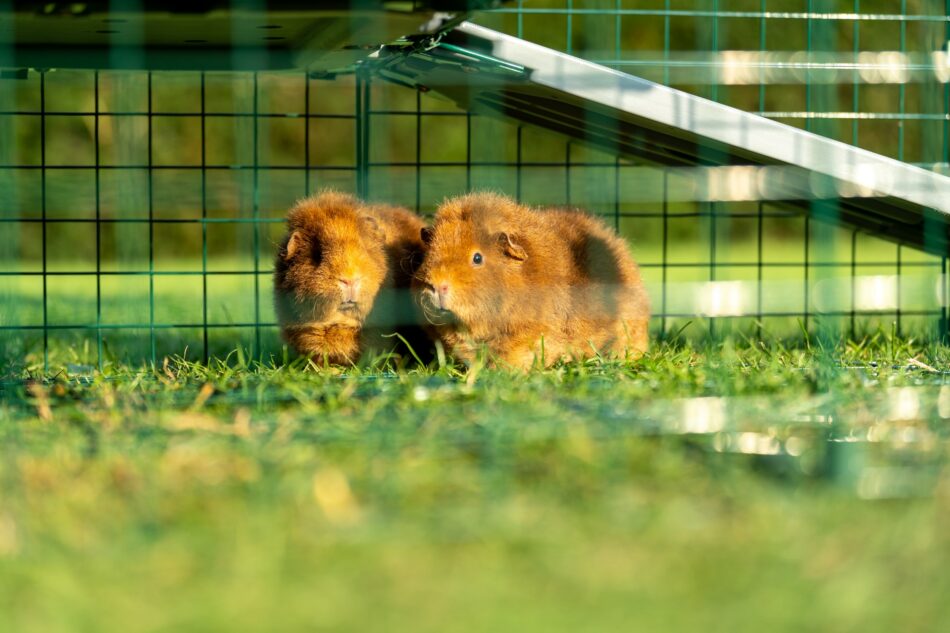
Keeping your cavies cool
If you take a look at guinea pig anatomy, you’ll quickly see why they aren’t built for extreme temperatures. They don’t have sweat glands to help release heat, and their rapid respiratory rate is inefficient in hot or humid air. And, while their potato-shaped bodies may be part of their charm, their physique traps more heat than needed during hot weather.
Ideal temperatures for guinea pigs lie between 65-75°F. Once ambient temperatures exceed 80°F, the risk of heat stress rises. At temperatures of 85°F or higher, guinea pigs can develop heatstroke quickly. Guinea pigs housed outdoors may be more tolerant to elevated temperatures, but it’s critical to monitor your pets closely once the temperatures reach these danger zones.
How to keep guinea pigs cool
As long as the temperatures in your guinea pigs’ area can be kept consistent, your cavies can enjoy summer safely. The caveat to guinea pig breeds that can tolerate higher temperatures are Skinny Pigs, which should never be kept outside due to their lack of fur. Here are some ways to help your fully-furred cavies stay cool during the summer months.
Create shade
An insulated guinea pig hutch is a must when combating extreme temperatures. And to enhance its performance, keep your guinea pigs’ hutch in a shaded area with good ventilation. Under shade trees, a covered patio, or next to a north-facing wall will allow for optimum shade. Add guinea pig run covers to provide shade outside of the hutch, and consider reflective sheeting to help redirect sun rays.
Offer cool elements
Ceramic tiles or terracotta saucers in your guinea pigs’ run aren’t just aesthetically pleasing. Chill them in your refrigerator or freezer before adding them to your cavies’ run for a cooling element they can flop onto. You can also freeze water bottles and wrap them in a thin towel for your guinea pigs to snuggle up against.
Up the airflow
Oscillating or box fans can circulate stagnant air, which can reduce the temperatures around your guinea pigs setup. Angle them so that their breeze passes over and through their run, but not directly onto your cavies to prevent respiratory issues. In drier climates, you can add a patio mister in front of a fan for an evaporative cooling effect.
Boost their hydration
Making sure your guinea pigs are well hydrated in the hottest months is vital to their wellbeing. Mount extra water bottles or crocks around their setup, and refresh them daily with cool (not icy) water. Offer water-rich vegetables like cucumber, romaine lettuce, and bell pepper in a hanging guinea pig treat holder, but remember to offer these treats in moderation.
Rethink bedding
Summer isn’t the time for deep layers of bedding. Swap shavings and straw for thin fleece liners over absorbent pads to wick away excess moisture and to improve airflow. If you choose to stick with bedding, opt for thin layers of recycled paper pup or pine pellets to avoid trapping heat. Remember to spot clean regularly, as wet bedding warms up quickly and increases humidity.
Schedule playtime wisely
Guinea pig play pens and tunnels are best to be made available during the early morning and late evening hours to avoid the hottest part of the day. And, remember to check how hot any surface is before placing your guinea pig on it to play — especially pavement, synthetic grass, or decking. A pop-up guinea pig playpen with flooring can be used for quick play sessions without having to worry about their feet.
Bring them inside
If your area has sustained temperatures above 80°F, it may be time to bring your cavies indoors for the summer. It’s important to remember that if you bring your guinea pigs inside, they’ll need to remain in this climate controlled setting until indoor and outdoor temperatures are in alignment. If you do bring your cavies in for the summer, keep them in a room with adequate airflow and away from windows, appliances, and upper levels, which are typically the warmest spots in a home.
Signs of heatstroke in guinea pigs
If your cavies are weathering the summer outside, it’s important to be aware of the signs of heat stress and heatstroke in guinea pigs. Heat stress can rapidly progress to heatstroke, at which point a guinea pig’s vital organs begin shutting down. Signs of heat stress in guinea pigs include:
- Rapid, shallow breathing
- Lethargy
- Warm, reddened ears
- Fur damp from saliva
If left unaddressed, heat stress can quickly turn into heatstroke. Sings of heatstroke in guinea pigs include:
- Open-mouthed panting
- Weakness or staggering
- Drooling or frothy saliva
- Convulsions or collapse
If you suspect heat stress in your guinea pigs, quick action can save their lives. Move them to a cooler area right away, and lower their body temperature slowly. Lightly mist a cloth with cool (not cold) water and wipe their ears, feet, and belly. Don’t submerge or drench your guinea pig in cool water, as a sudden change in temperature can cause shock. Offer cool water, but don’t force them to drink. If you don’t see noticeable improvement a few minutes after these measures, it’s time to call the veterinarian.
Omlet and your guinea pigs
Not every climate is kind to cavies all year round, but our guinea pig products keep them as comfortable as possible in any setting. From supportive outdoor guinea pig hutches to guinea pig playpens that can easily be set up indoors for temporary accommodations, we’ve invented what you need to keep your cavies cool and comfortable — inside and out.
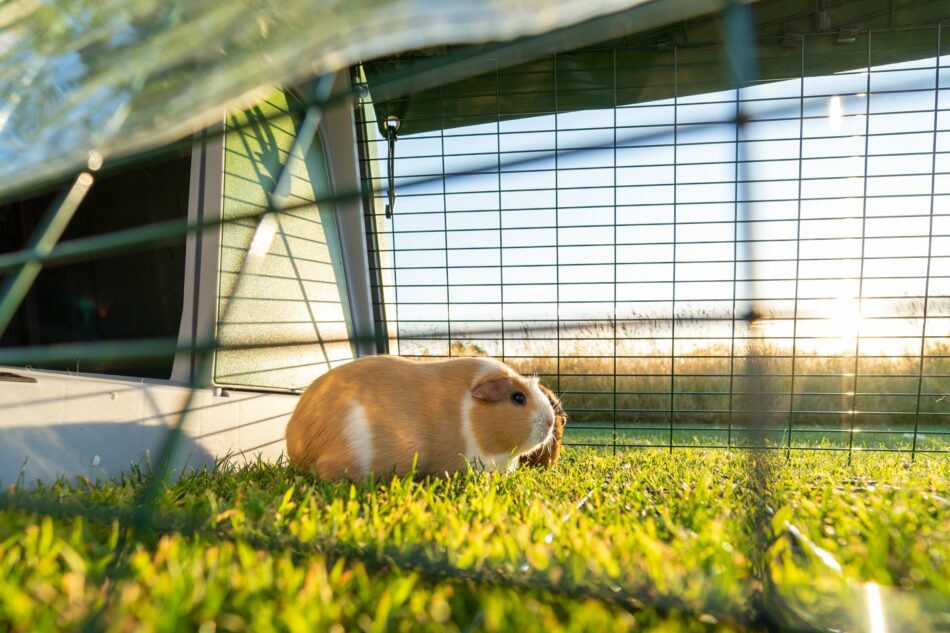

This entry was posted in Guinea Pigs
With school out for the summer, kids have time to slow down, explore, and reconnect with their surroundings, family, and themselves. For families with small pets, the long school break opens up plenty of fun for kids with rabbits and guinea pigs. Over the summer, your child can build stronger bonds with their furry friends and discover just how much joy they can bring. From creating ideal habitats to learning about their care and behavior, there are plenty of engaging and enriching ways kids can connect with their rabbits or guinea pigs. Whether it’s their first break together or they’ve been best buds for years, here’s how to help your kids make the most of their time with their pets.
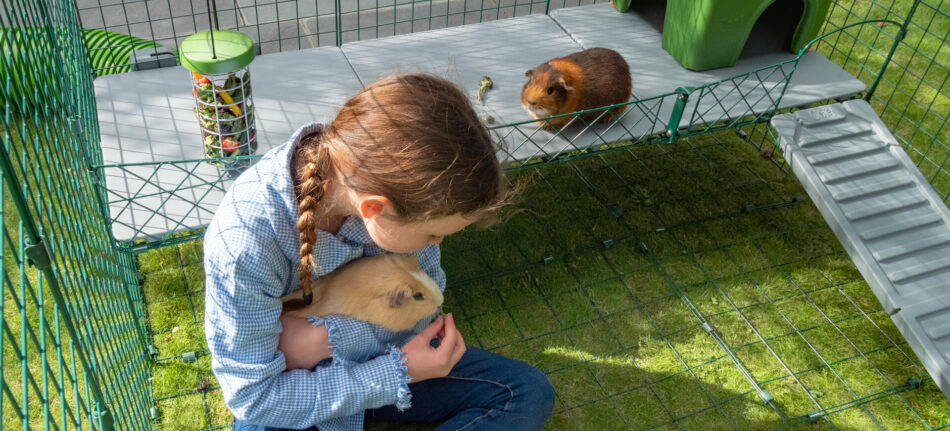
Make this summer special
Rabbits and guinea pigs are gentle, intelligent, and social animals, and they thrive when given attention and interaction. Summer break is an ideal time for kids to slow down and spend quality time getting to know their pets better. Here are some fun, educational, and creative ways to keep everyone’s days full and happy.
Build routines and bonds
Summer is a great time to start new routines that help kids and pets connect. By caring for rabbits or guinea pigs, your child will learn responsibility, create lasting relationships, and experience the power of empathy and creativity. To set your children and their pets up for success this summer:
- Treat daily care as a learning experience. Involve children in feeding, cleaning, and water changes. This teaches responsibility and helps kids learn that pets rely on them for care and comfort.
- Encourage your children to read to their rabbits or guinea pigs. Summer reading programs are in full swing, and what better way to motivate them than sharing their book with their small companions?
- Teach gentle and proper handling techniques. Holding a rabbit or guinea pig is a rewarding experience, but safety should always be paramount — both for the pet and your child.
After a week or two of your child being involved in their care, rabbits and guinea pigs should begin to recognize their voice and presence and display recognition or appreciation. That’s when the real bonding begins — and it’s a beautiful thing.
A supportive setup
Summer is a great time to get outside to design your pets’ space. Start with a supportive rabbit and guinea pig hutch and run as a base, then add elements to help them through the heat of the summer. Add fresh, seasonal offerings in a Caddi Rabbit and Guinea Pig Treat Holder to elevate snacktime, or implement Zippi Rabbit and Guinea Pig Ramps and Platforms to add space and shade to their run.
Create the ultimate play space with an above-ground burrow, made possible by Zippi Rabbit and Guinea Pig Tunnels. Connect the pipes to Zippi Playpens and their hutch to create different areas of exploration. Different pens for food, playtime, or foraging simulates the natural burrow structure of wild rabbits and guinea pigs.
Activities for curious minds
Kids, rabbits and guinea pigs have something in common: curious minds. For these small pets, stimulation is important to stay healthy and happy. Your child can get creative with fun enrichment activities. Here are some ideas:
- DIY foraging games: Fill cardboard rolls with hay and a few healthy treats, or scatter veggies in a dig box of shredded paper or hay.
- Obstacle course and tunnels: Use tunnels, ramps, and boxes to build a mini playground. Kids will love watching their pets explore and solve “puzzles.”
- Training basics: With supervision, older children can try simple training like litter box use or following a treat target. Rabbits and guinea pigs can learn surprising tricks with patience and gentle encouragement.
The power of observation
Spending time with their furry friends can help kids become better observers of animal behavior. Encourage your child to sit quietly and notice what their pets do: do they chatter their teeth, flop on the ground, or popcorn? These behaviors help kids understand the language of rabbits and guinea pigs.
For additional educational value, help your child understand where rabbits and guinea pigs come from, what they eat in the wild, and their natural habitat. Turn their research into a summer research project or journal. Take and print photos of your rabbits or guinea pigs to add to their data.
Comfortable companionship
Not all of the fun of summer has to be fast-paced or action-packed. This time off from school offers an opportunity for rest and stillness — and rabbits and guinea pigs can be excellent quiet-time companions. Once they’ve been acquainted, invite your rabbit or guinea pig to sit with your child during a movie or while they read. Or, simply have your child sketch a drawing as they watch their pets for simple, wholesome, screen-free entertainment. Just spending time watching a rabbit or guinea pig nibble hay can be calming, and helps them (and parents) appreciate the little things in life.
Omlet and your small pets
With Omlet, it’s easy to keep rabbits and guinea pigs safe, happy, and entertained, no matter the season. From the cozy Eglu Go Rabbit and Guinea Pig Hutch to spacious Zippi Runs and Playpens, kids can take an active role in setting up enriching, secure environments for their small pets. With our customizable setups, your pets — and children — can explore and play to their hearts’ content. Whether they’re watching their rabbit or guinea pig race through Zippi Tunnels, or nibble on an offering from their Caddi Treat Holder, our products help turn everyday moments into something magical.
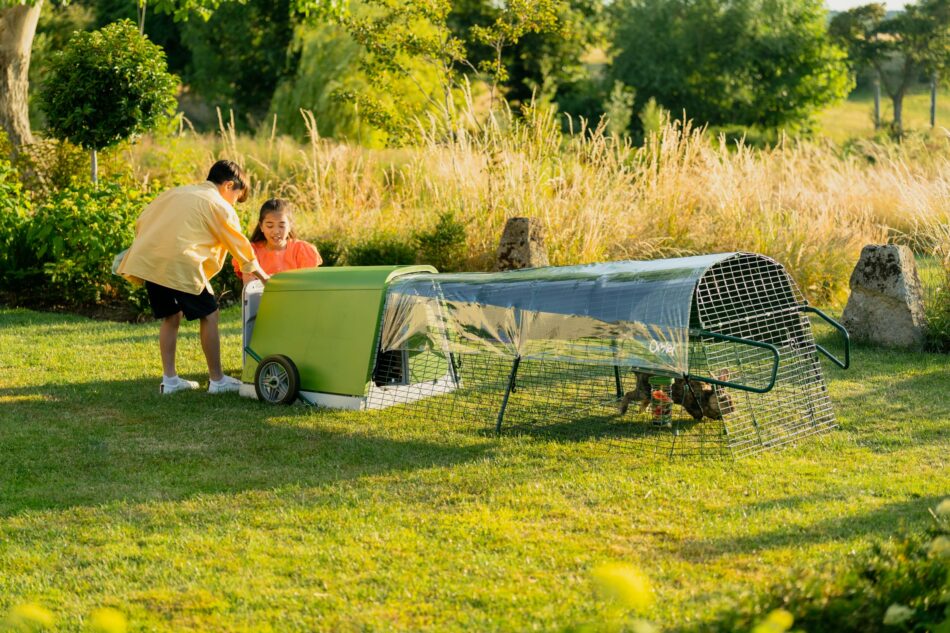

This entry was posted in Guinea Pigs
Thinking about adding a small, sociable pet to your family? Consider cavies — aka guinea pigs — as a fun, gentle pet that the whole family can enjoy. Learn everything you need to know about them in guinea pig care 101. From their care to understanding their behaviors, here’s the scoop on keeping guinea pigs healthy and happy and how to create cavy companionship that will last a lifetime.
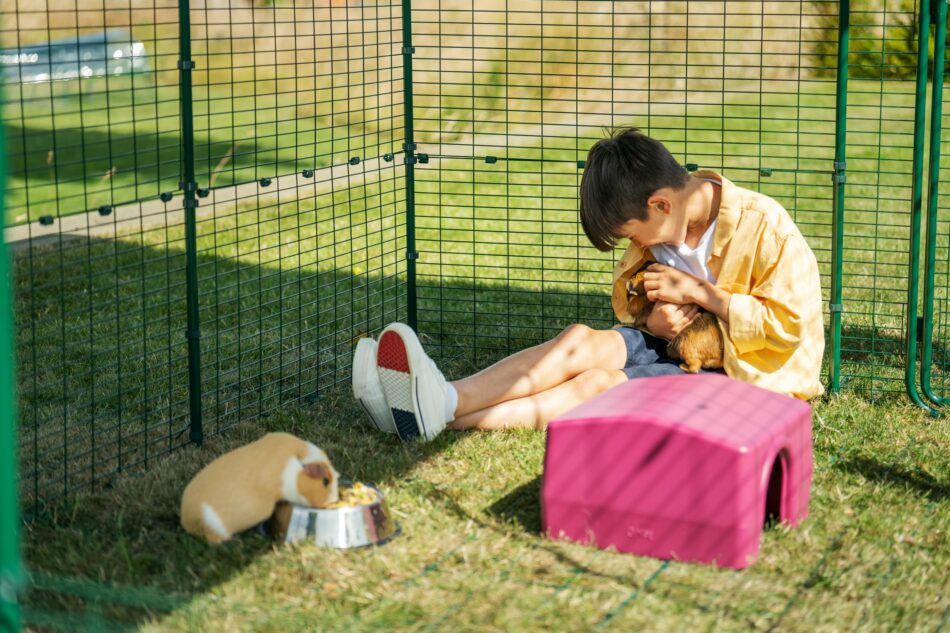
What to expect with guinea pigs
Guinea pigs are known for their sweet temperaments and social nature, and come in a variety of cavy coat textures and colors. But like all pets, guinea pigs have their own unique personalities. From diet and housing to health and hygiene, understanding their core needs will set the foundation for a rewarding bond.
Guinea pigs as pets
There’s no doubt about it: cavies are captivating. From their unique vocalizations to their adorable appearance, guinea pigs can bring years of enjoyment to families. Guinea pigs are members of the rodent family, and are active, personable, and entertaining to have as companions. They thrive in pairs or small groups — a single guinea pig should never be kept alone. Children can care for cavies with the help of adults, and most guinea pigs are receptive to being gently handled.
Cavies communicate through a range of sounds. This guinea pig language can range from excited squeaks — or “wheeks” — to low rumbles and soft chattering. They’ll quickly learn to associate you with food and attention, and most guinea pigs will welcome their owners with a series of sounds from their repertoire.
They’re best for people who can spend time each day offering gentle interaction and basic care. While they may be more sturdy than other rodents, they require a steady hand and calm environment to feel safe.
Diet
A healthy guinea pig diet is centered around one key element: hay — and lots of it. Unlimited fresh hay is essential for their digestion and for keeping their ever-growing teeth in check.
A balanced guinea pig diet includes:
- Unlimited fresh grass
- Unlimited hay (timothy hay for adults; alfalfa for younger cavies).
- Daily vegetables and leafy greens like romaine, bell peppers, carrot tops, or cucumber.
- Pellets fortified with Vitamin C (guinea pigs cannot produce their own)
- Fresh water, refreshed daily.
Fruits can be offered only as occasional treats, and sugary or starchy foods should be avoided. Be cautious with iceberg lettuce, which offers little nutritional value, and vegetables high in oxalates like spinach or parsley in large quantities.
Housing
Cavies need more space than many people realize. They are active animals that enjoy running, hiding, and socializing with their enclosure mates. Cramped, traditional guinea pig cages lead to boredom and health issues like obesity or illness.
Ideal guinea pig housing includes:
Most guinea pigs do remarkably well when housed outdoors. However, certain breeds like Skinny Pigs should be housed indoors since they don’t have hair to help regulate their body temperature. Peruvians are another guinea pig breed that should be monitored closely outdoors due to their long coats.
You’ll need to spot clean your guinea pigs’ hutch daily to keep it fresh — and thoroughly clean their hutch weekly by replacing the bedding, wiping or spraying the smooth surfaces clean, and cleaning their bowls and toys. Choose a soft, absorbent bedding to keep dust and odors down, and to support good sleep.
Social needs
Unlike their rodent cousin the hamster, guinea pigs should never be housed alone. Cavies are highly social and should always be kept in pairs or small groups. A bonded pair of the same sex or a neutered male with a female are the most successful pairings. Their interactions provide comfort, stimulation, and emotional security.
While they enjoy human interaction, guinea pigs can be shy at first. Gentle, consistent handling helps build trust. Talk to them softly, move slovenly, and offer food by hand to reinforce positive experiences.
Health care
Guinea pigs are relatively hardy, but they do have some unique health considerations. Regular observation is key — many illnesses can be subtle until they become serious.
Here are some signs that point to illness in guinea pigs:
- Changes in eating or drinking habits
- Weight loss or lethargy
- Discharge from the eyes or nose
- Limping, bloating, or labored breathing
- Overgrown teeth or drooling (indicative of dental issues)
Routine vet visits with a cavy-savvy veterinarian are helpful in keeping your guinea pigs healthy and happy. Nail trimming, grooming (for long-haired breeds), and checking for external parasites like lice or fleas should be part of your care routine.
It’s also important to be sure that your guinea pigs are getting enough Vitamin C, as deficiencies can lead to scurvy — a common, but preventable issue. Most commercially bought guinea pig feed is fortified with Vitamin C, but check the ingredients to be sure, and work with your veterinarian to see if your cavies need additional supplementation.
Other considerations
While not necessarily a necessity, accessories can elevate your guinea pigs’ — and your — experience. Consider adding these fun and engaging elements to your cavies’ setup:
These accessories have been designed to foster natural behaviors of guinea pigs, and provide endless opportunities for exercise and excitement.
Omlet and your rabbits
At Omlet, we believe your guinea pigs’ habitat should be just as smart and thoughtfully designed as your own home. Our Eglu Go Guinea Pig Hutch provides a safe, easy-to-clean, and weatherproof space for outdoor cavies. Round out your setup with Zippi Guinea Pig Runs and Playpens and Zippi Guinea Pig Tunnels to provide essential enrichment that all speak to their nature. Our products — combined with your love — make it possible to care for your guinea pigs in a simple, sustainable, and supportive way for years of cavy companionship.
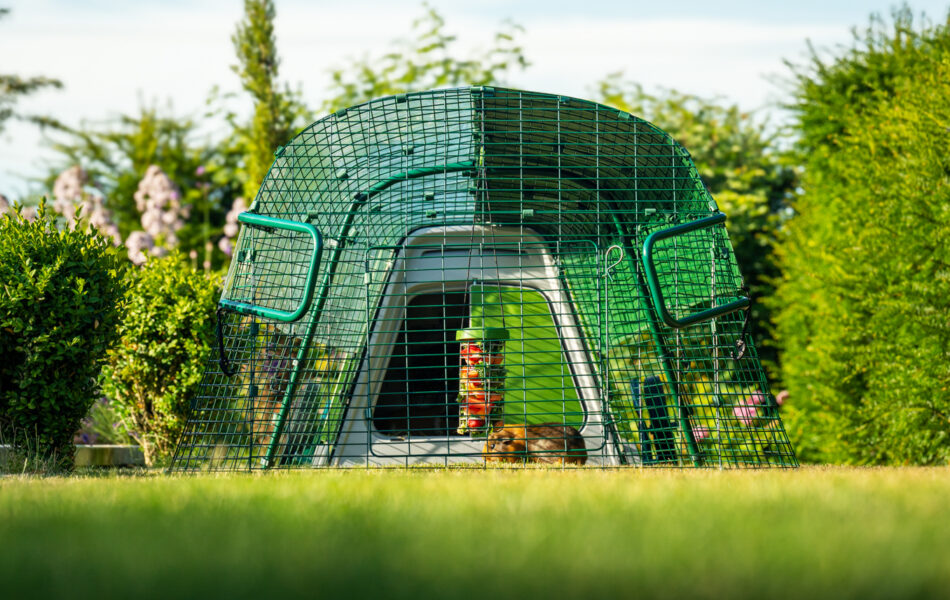

This entry was posted in Guinea Pigs
Looking for some setup ideas for your small pet? With the beautiful weather and fresh air, your rabbits and guinea pigs are kicking their outdoor activities into high gear. Here’s how to maximize their space, offer plenty of enrichment, and keep them safe in their outdoor setup.
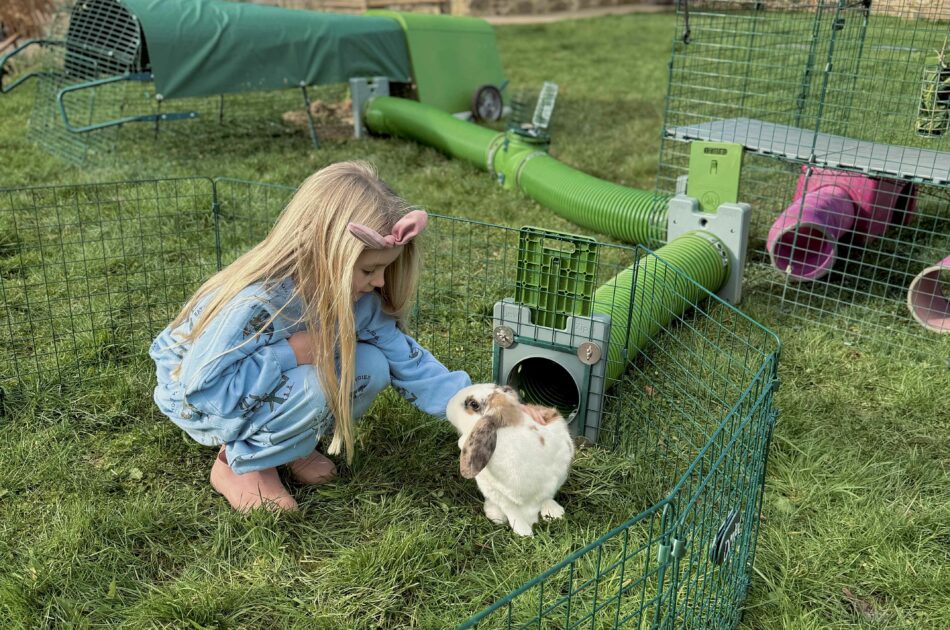
Small pet outdoor setups
Your rabbits’ or guinea pigs’ outdoor setup is more than just a space to play — it should offer them ample protection from the elements and predators. So before designing their inner sanctum, you’ll want to be sure that their enclosure is as safe as possible. To start your rabbit or guinea pig setup, make sure you have:
Once you’ve invested in these essentials, it’s time to create the perfect environment within.
Appeal to their nature
One of the best ways to ensure your rabbits’ and guinea pigs’ happiness is to appeal to their natural instincts and behaviors. For these small pets, activities like foraging and burrowing top the list. Thankfully, there are several ways to incorporate these activities in their outdoor space.
In the wild, rabbits excavate extensive tunnel systems. These tunnels provide shade and shelter while allowing them to exercise and explore. And while they may not dig their own, wild guinea pigs seek the shelter and safety of burrows created by other animals. This activity is a favorite of most rabbits and guinea pigs, and should be fostered whenever possible. Here are some ideas to create rabbit and guinea pig-friendly burrows in their setup:
- Create an above-ground burrow with a Zippi Rabbit and Guinea Pig Tunnel System that can be connected to any hutch or run.
- Cover a large-diameter PVC pipe with sod or top soil to create an earthy tunnel.
- Offer plenty of rabbit shelters or guinea pig hides throughout their enclosure.
- Partially bury large terracotta pots laid on their sides to create a cave-like shelter.
- Create a “dig box” for rabbits using a plastic container large enough for them to hop into, filled with hay, shredded paper, untreated sand, or other rabbit-safe substrates.
Foraging is also important for both species. Use a hanging rabbit and guinea pig treat holder to simulate this activity in their enclosure. Offer leafy greens, herbs, and other bunny and cavy-safe treats at a level that encourages them to stretch and scrounge for diverse vegetation.
Create more space
Like most pets, rabbits and guinea pigs thrive when they’re provided as much space as possible. This can be accomplished several ways, and it’s as beneficial for you as it is for your small pets:
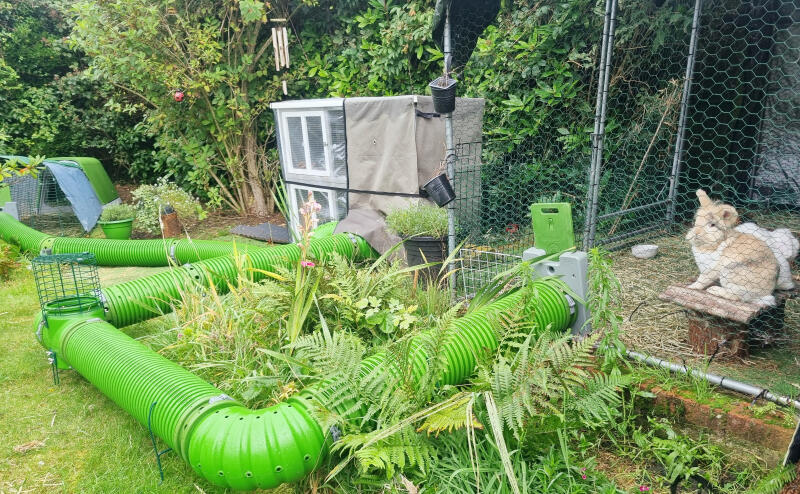
By connecting multiple runs and playpens together, you can change your pets’ experience between each of their areas. For example, one area can be dedicated to feeding, while another could hold enrichment items like toys, dig boxes, and treat holders. This further simulates the feel of a burrowing system that your pets would be utilizing in their natural habitat.
DIY and complementing elements
DIY options for your rabbits’ and guinea pigs’ enclosure can be a fun project, and many are inexpensive. Some ideas include:
- Cardboard box mazes
- Paper towel or toilet paper tubes stuffed with Timothy hay
- Edible garland made from fresh veggies
And, with rabbit and guinea pig droppings being prime fertilizer for gardens, planting a garden near your rabbits’ or guinea pigs’ setup gives your plants quick access to nutritional excellence. You can also plant rabbit and guinea pig-safe plants and herbs in planters along the edges of your small pets’ run for them to nibble through the openings in the wire.
What to avoid in your small pets’ setup
Along with items safe for your bunnies’ and cavies’ setup, there are also elements to avoid. These include:
- Towels or other cloth materials that a toenail could easily snag on
- Plush toys (unless during supervised play)
- Electrical cords within reach of your pets
- Treated lumber
- Cedar wood or shavings
- Objects small enough for your rabbits or guinea pigs to choke on
This isn’t an exhaustive list, so if you’re unsure about what may or may not be safe for your pet, conduct thorough research through reputable sources. Breeders, national associations, rescues, and veterinary offices are all excellent resources to help you make safe choices for your small pet’s setup.
Omlet and your small pets
At Omlet, we believe that pet ownership should be about mutual fun, love, and companionship. That’s why we created safe rabbit and guinea pig hutches that are easy to clean and will keep your pets comfortable all year round. Combined with our line of Zippi Rabbit and Guinea Pig playpens, Zippi Rabbit and Guinea Pig Tunnel System, and Zippi Rabbit and Guinea Pig Platforms, your bunnies and cavies will have a small pet setup that will entertain and support them in every season.


This entry was posted in Guinea Pigs
The upcoming season is one of the best for small pets, and creating your spring checklist for rabbits and guinea pigs is part of the fun. With sunshine, grass, and vegetation returning, it’s the perfect time to spruce up your pets’ outdoor space, or to set up their home as a first time bunny or cavy owner. Here’s everything you need to make sure your rabbits and guinea pigs are all set for spring and beyond.
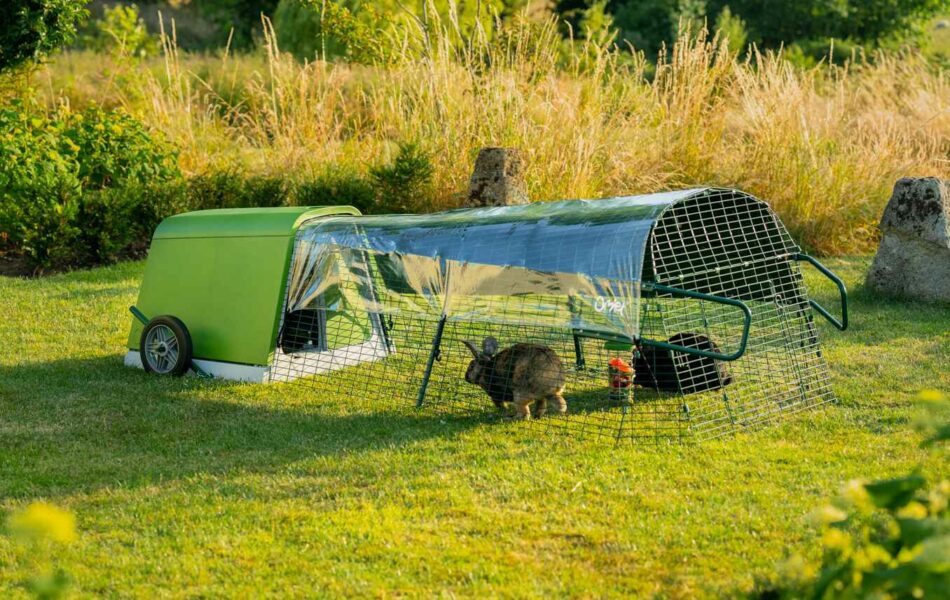
Outdoor rabbit and guinea pig setups
Your pets’ outdoor setup should be safe, secure, and supportive. Rabbits and guinea pigs are prey animals, and they need to feel protected in their environment in order to fully enjoy their experience outside. To create a safe rabbit or guinea pig setup, you’ll need:
With all of these elements in place, you’ll be able to create a safe and supportive space that will enable your rabbits and guinea pigs to enjoy spring outside in their natural environment.
An outdoor hutch
Rabbits and guinea pigs need a safe outside space to retreat to in the event of adverse weather, and to keep them safe from predators. Their hutch serves as their house, and should be both comfortable and protective. This is especially true if you intend to house your bunnies or cavies outside full-time.
An easy to clean, insulated rabbit and guinea pig hutch is the best choice for keeping your small pet safe and supported while they’re outside. The Eglu Go Rabbit and Guinea Pig Hutch is safe and strong, and only takes a couple of minutes to clean thoroughly, protecting your pets against predators, the elements, and unsanitary living conditions.
Plastic rabbit and guinea pig hutches also have the advantage of not becoming chew toys for your pets. Rabbits and guinea pigs love to chew on wooden surfaces, and most traditional hutches are chewed to the point of compromising their structural integrity. With strong plastic hutches, you’ll never have to worry about your pets gnawing their way into a hazardous scenario.
Room to run
Your rabbits’ and guinea pigs’ run is another vital component of their outdoor setup. Rabbit runs should have strong mesh to act as flooring to prevent tunneling out, while guinea pigs need to have constant contact with the ground to promote good foot health.
Guinea pig and rabbit runs can easily be connected to an Eglu Go Rabbit and Guinea Pig hutch, and can be lengthened with expansion kits to give them more room to run. The attached runs are fully enclosed with heavy-duty weld mesh to protect against predators of all shapes and sizes.
If you have a traditional wooden hutch, or want to provide even more space, Zippi Rabbit and Guinea Pig Runs and Playpens can be set up anywhere you need them. Or, for the ultimate outdoor space, a Walk In Rabbit and Guinea Pig Run allows you convenient and comfortable access to play with your pets.
Protection from the elements
Weather covers keep your cavies and bunnies dry, shaded, and protected from the wind. They can be securely attached to your pets’ runs in just seconds, and are made from heavy-duty material designed to last a lifetime. The solid covers are perfect for blocking UV rays, while the clear covers allow warming sunshine to permeate the run during the cooler days of early spring.
Additional elements
While not a must-have item, one of the single most fun activities to enjoy with your rabbits and guinea pigs is to watch them race through Zippi Rabbit and Guinea Pig Tunnels. Create a course custom to your space and your pets’ skill level, and grow it as often as you’d like. The quick-connectors allow you to arrange and rearrange their above-ground burrow with ease, allowing you to change up the configuration for more of a challenge. Both bunnies and cavies enjoy burrows as part of their nature, and Zippi Tunnels appeal to this instinct handed down by their wild ancestors.
Guinea Pig and Rabbit Ramps and Platforms are another non-essential, but excellent addition to your small pets’ outdoor setup. The platforms give your pets shade and seclusion below, and a new vantage point above. And, the elevated surface is perfect for interacting with you on a whole new level. The ramp helps strengthen leg muscles — especially for guinea pigs — and makes use of vertical space in their run.
Rabbit shelters guinea pig shelters are also helpful in providing additional privacy and security while your pets are out and about in their runs. And, Caddi Rabbit and Guinea Pig Treat Holders can be added to your pet’s run to encourage foraging behaviors for healthy and nutritious snacks. Both of these accessories encourage and foster natural behaviors to help your pets get in touch with nature.
Omlet and your small pets
Check off your outdoor rabbit and guinea pig essentials list with Omlet, and ensure they have safe, supportive setups this spring, and for every season after. With an exceptionally safe rabbit and guinea pig hutch, a spacious outdoor rabbit and guinea pig run, and exciting elements like above-ground burrows, you and your pets can have the best spring ever — at least until next year, when you can enjoy it all over again.
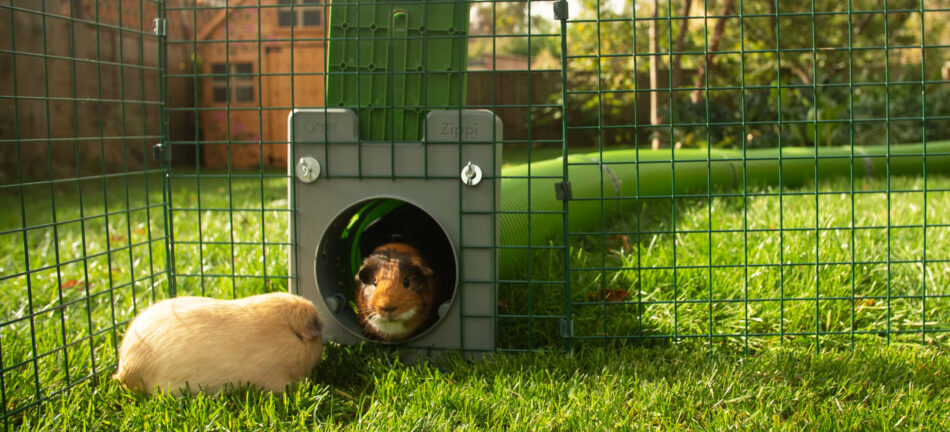

This entry was posted in Guinea Pigs
Understanding rabbit and guinea pig behavior sets the foundation for a lifelong relationship with your pets. And when you take cues from your bunnies and cavies, you’ll know how to help them live long, healthy, and fulfilled lives. Here’s everything you need to successfully keep rabbits and guinea pigs, and how these elements help foster their natural behaviors.
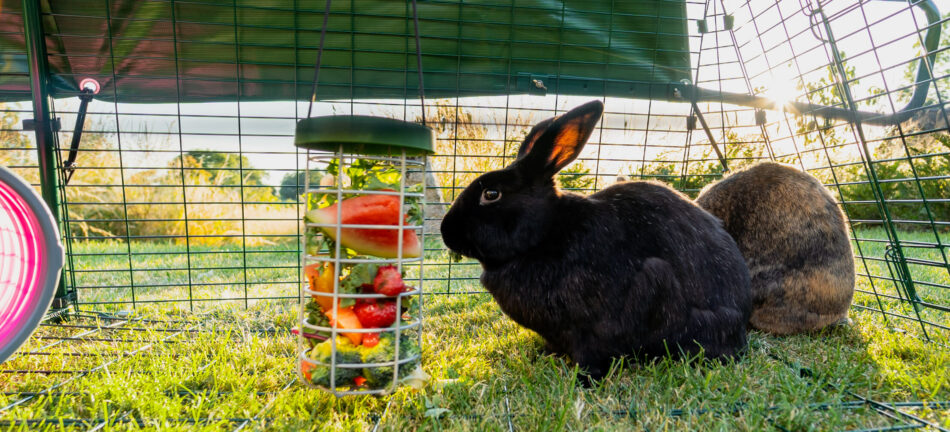
Rabbit and guinea pig basics
Keeping rabbits and guinea pigs should be enjoyable, so choosing products that speak to their natural behaviors while being easy on your workload are a win-win. Here’s everything you need to foster a relationship with either rabbits or guinea pigs.
A safe hutch and run
As prey animals, rabbits and guinea pigs need to feel safe in their home. Both species need quiet, insulated, enclosed hutches to get a reprieve from the stimulating outside world and to keep them safe from predators and the elements. Providing a safe Rabbit and Guinea Pig Hutch is vital for their happiness and health. But what constitutes safety? A safe rabbit and guinea pig hutch will effectively protect your pets from all threats, from the weather to predators like hawks and raccoons. This refuge will be where your rabbits go to retire for the day, and what your guinea pigs will gravitate toward.
Quality food and fresh water
Both bunnies and cavies have teeth that continuously grow, and their diet helps them keep them in check. Quality pellets made from Timothy hay, and fresh Timothy hay offered free-choice will help keep their teeth filed down, as well as help their digestive tract move smoothly.
Guinea pigs also need vitamin C fortified feed, as they cannot manufacture their own. Bunny and cavy-safe treats like lettuce or other fresh fruits and vegetables can be offered in a Caddi Rabbit and Guinea Pig Treat Holder to supplement their diet in a nutritious and engaging way.
Bedding
Soft bedding should be provided to rabbits and guinea pigs to rest and nest in. Think of your bun or cavy’s bedding as a mattress topper and duvet for you — something soft to sink into at the end of the day. In the warmer months, pine shavings or pellets are a nice choice, as they don’t trap much heat. During the winter, opt for a thick layer of straw to help bolster their hutch insulation. Recycled paper pulp bedding also offers comfort year-round. Bedding also absorbs moisture and odors, helping to keep your pets’ hutch and their coats clean and fresh.
Bonus elements
With the essentials on hand, you’ll provide your rabbits and guinea pigs with what they need in order to be healthy and happy in their home. But there are some additional elements to add to elevate ordinary life to an extraordinary level. These accessories might not be essential to the health of your bunnies and cavies, but they will do wonders for their minds and bodies — and for your own enjoyment.
Above-ground burrows
In the wild, rabbits build extensive tunnels, known as burrows, to form a large network called a warren. Multiple rabbits share a warren, and use the connected burrows to relay messages, access the above-ground world, as well as for sleeping, eating, and shelter during times of danger or weather events. And while they may not dig their own, wild guinea pigs will find abandoned burrows or dens dug by other animals for the same purposes.
Investing in some Zippi Rabbit and Guinea Pig Tunnels simulates this type of burrowing network, and makes it easy for you to create new routes and pathways to explore. Having these above-ground burrows channels their natural instinct and provides a sense of safety and shelter, whilst making their home more exciting.
Platforms for prime viewing
Being animals of prey, rabbits and guinea pigs often seek a higher vantage point to get a better view of the world around them. Rabbit and Guinea Pig Platforms give your pets this space to get a glimpse of their surroundings, while also offering a shaded space below. The ramp exercises their leg and back muscles, and the elevated surface helps you interact with your pets on a whole new level.
Spacious playpens for epic play sessions
Rabbit and Guinea Pig Playpens are the perfect space to hangout with your pets, or for conducting training sessions, grooming, or playtime. Connect multiple playpens together to create the ultimate warren, or opt for a fully-enclosed Walk In Rabbit and Guinea Pig Run for all-around safety and comfort. The more space you can provide your bunnies and guinea pigs with, the better it is for their minds and bodies.
Other considerations
While these might not be tangible goods, there are some other angles to consider when keeping rabbits or guinea pigs. These provisions will ensure that your bunnies or cavies are being supported in aspects beyond their housing and enrichment. They include:
- Veterinary care for if your rabbit or guinea pig experiences illness or injury. Be sure to research veterinarians that treat rabbits and guinea pigs specifically, as they aren’t part of every small animal veterinarian’s realm of expertise. A veterinarian can also spay or neuter your rabbits or guinea pigs if needed.
- Choose a pet sitter for when you need to go out of town. Bunnies and cavies should be fed daily, so someone will need to care for them while you’re away. Keep an updated list of care instructions to provide, and invite your designated pet sitter over to introduce them to your pets ahead of time.
- Set expectations for you and your pets. Part of understanding rabbit and guinea pig behavior is observing them and recognizing when they’re being pushed out of the comfort zone. Always make sure to interact in a place and at a pace that your pets are comfortable with, being sure to make each interaction as positive as possible.
With these things in mind, along with a supportive setup, your bunnies and cavies will be equipped to share a lifetime of experiences with you.
Omlet and your rabbits and guinea pigs
All over the world, pet parents of rabbits and guinea pigs choose Omlet to house and provide for their furry family members. From ultra-strong and supportive Rabbit and Guinea Pig Hutches and secure Rabbit and Guinea Pig Playpens, to unique Zippi Rabbit and Guinea Pig Tunnels and Rabbit and Guinea Pig Platforms, you’ll appeal to your bunnies’ and cavies’ natural behaviors and foster the bond forged between pet and owner with our ingenious pet products.
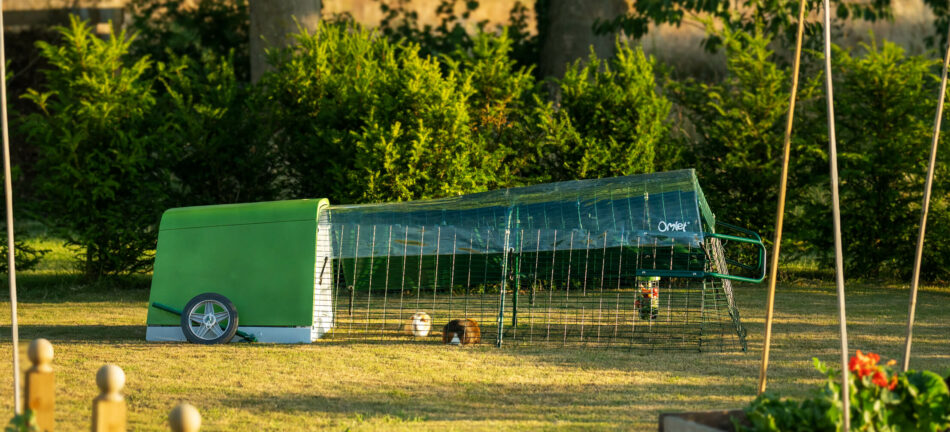

This entry was posted in Guinea Pigs
It’s officially fall — the air is crisp, the leaves are changing, and the temperatures are dropping. But these changes don’t go unnoticed by your four-legged family members. Find out how to help your rabbits and guinea pigs cope with the changing seasons, and learn what to expect from your pets as they make the transition into the colder, wetter weather.

Combating the cold
For many rabbit and guinea pig owners, cold weather is a reality that fall brings. The best way to help your pets cope with the cooler temperatures is to ensure they have an insulated rabbit and guinea pig hutch. This will give them a reprieve from the bite in the air, and allows them to acclimate to the outdoor temperatures on their own terms.
While most bunnies and cavies that are accustomed to spending time outdoors will thrive in the crisp temperatures, it’s important to keep a close eye on them. Watch for signs of hypothermia in rabbits and guinea pigs, which include:
- Shivering
- Lethargy
- Pale feet or mucous membranes
As the temperatures approach freezing, it’s especially important to keep an eye on your guinea pigs. While they can thrive outdoors throughout the majority of the year, if you live in an area that experiences extreme temperatures, it’s time to bring your guinea pigs indoors for the season. Skinny pigs are of particular concern, and should not be housed outdoors during any season. Since they lack fur, they aren’t able to regulate their body temperature as well as their furry cousins.
Support through the storms
Some rabbit and guinea pig owners have to prepare for wild weather events during the change of seasons. The cooler fall air mingled with the lingering warm weather has the potential to cause severe storms and heavy rainfall. For coastal regions, this may even mean preparing your bunnies and cavies for hurricane season, which peaks during the fall. Equipping your rabbits’ or guinea pigs’ hutch with wheels and handles enables you to move their setup whenever severe weather is in the forecast.
Rabbit and guinea pig run covers will keep the worst of the weather off of your pets. The clear covers allow warming sunlight for your bunnies to bask in, while being waterproof to keep your cavies clean and dry. When positioned along the sides of the run, these covers act as a barrier from the brisk winds.
When fur falls
Leaves aren’t the only things falling — you’re likely seeing tufts of your rabbits and guinea pigs hair tumbling around their run. This is due to the phenomenon known as molting. Molting is a process that nearly every furred or feathered animal experiences, involving the loss of fur or feathers in order to grow new ones. Most animals molt in the spring to shed excess fur for the summer, and in the fall to grow more dense coats for the approaching colder weather.
Rabbits molt during the fall, resulting in discolored or uneven coats. Guinea pigs molt too, but depending on their breed, the texture of most guinea pig coats won’t have overly noticeable signs of their transformation.
Providing your pets of either species with plenty of water and nutrition-dense foods will support them throughout this process. And, because molting takes a lot of their energy, your cavies and bunnies may be more hungry than usual. Some nutritious treats to offer them include: fresh greens, squash, carrot tops, herbs, and bell pepper. Be sure to offer quality hay, preferably Timothy or orchard grass hay, at all times to help their digestive system move along. This is especially important in rabbits, who groom themselves meticulously and may ingest loose fur.
Hair loss from molting should improve within a few weeks. If you see bald patches or red, irritated skin, these are not usual signs of molting. Your bunnies and cavies should shed their old coats and don bright, healthy, new coats just in time for the winter.
Monitor for other changes
Along with the change in the weather, allergies are abundant. But pollen and chilly breezes can also irritate your rabbits and guinea pigs. Not all small animals will react to these changes, but some bunnies and cavies may be sensitive to these invisible irritants.
Performing regular health checks on your rabbits and guinea pigs will alert you to any changes in their demeanor or appearance. In the fall especially, be on the lookout for:
- Watery or crusty eyes and noses
- Hair loss from molting that doesn’t seem to be growing back
- Red, flaky, or irritated skin
If you notice changes in your rabbits and guinea pigs, contact your veterinarian. The fluctuations in weather patterns and temperature can affect some pets’ immune systems. Changing their bedding frequently and offering healthy treats like fresh fruits and vegetables will help support a healthy immune system. Opt for absorbent, dust-free bedding like recycled paper pulp or pine pellets, and choose an easy-to-clean rabbit and guinea pig hutches to ensure their health in every season.
Omlet and your pets
Providing your bunnies and cavies with supportive rabbit hutches and guinea pig hutches is your first line of defense against the elements. No matter the season, our insulated, easy to clean hutches will keep them safe, dry, and comfortable through any season. Combine them with outdoor pet runs and our one-of-a-kind rabbit and guinea pig tunnels, and you’ll provide them with hours of enrichment for warm hearts and bodies.
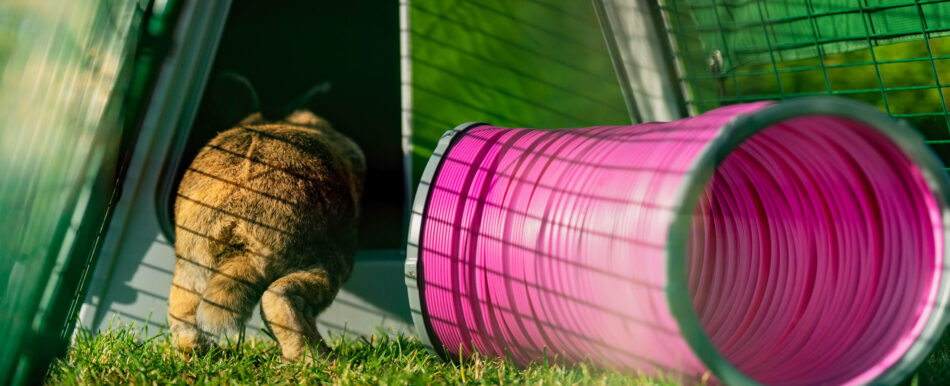

This entry was posted in Guinea Pigs
Thinking about adding small pets to your family, but caught up on the myths about keeping rabbits and guinea pigs? There are some common misconceptions about these pets that can sway new owners’ opinions of them. But we’re here to set the record straight and highlight the amazing attributes that these animals have to offer.
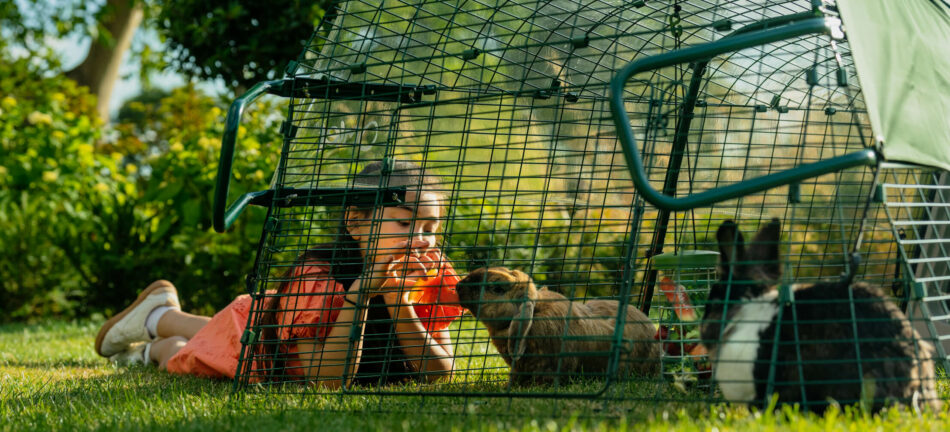
Rabbits
Rabbits make wonderful pets for owners of various ages and experience. They’re affectionate, intelligent, and are a joy to watch and interact with. But like all pets, bunnies have characteristics and preferences particular to their species that dictates their care, which has led to several myths surrounding them. Here are some of the most common myths about pet rabbits.
Myth: rabbits are low-maintenance pets for children
Fact: rabbits require daily care and careful interaction
Rabbits aren’t ideal for young children due to their care requirements and the skills needed to handle them safely. Their food and water should be refreshed daily, and they benefit from fresh greens and other rabbit-safe treats a few times a week. Bunnies also need their bedding changed regularly, otherwise they can suffer from flystrike — a serious condition that can result in death. Rabbits also need routine veterinary visits to have their teeth and nails trimmed if needed, and for general health checkups.
Their strong hind legs and sharp toenails make handling rabbits difficult for younger children. And, if startled or handled too roughly, rabbits can bite with their long front teeth. Because of these factors, rabbits should be primarily cared for by an older child or adult.
Myth: rabbits can live alone
Fact: rabbits need the companionship of other rabbits
Many people keep rabbits as solitary animals, but bunnies are very social animals that thrive in pairs or groups. In the wild, rabbits live in large family groups called colonies, and spend their days together. As pets, a pair of rabbits will groom each other, sleep together, and play throughout the day. Same-sex pairs are most successful with females or neutered males, or a spayed female and neutered male.
A singular rabbit can become depressed and listless, or even display negative behaviors like thumping, teeth grinding, or growling. To make sure bunnies live their lives to the fullest, it’s best to adopt them in pairs, or slowly introduce new rabbits together to form a bond. Once bonded, rabbits will live peacefully together for the duration of their lifespan.
Myth: rabbits love to be held and cuddled
Fact: most rabbits are nervous being held
As prey animals, rabbits are easily stressed being picked up and held. The act of lifting your rabbit simulates being snatched by a predator in the wild, and these instincts run deep. As a result, the majority of pet rabbits are not comfortable being held.
This doesn’t mean that you can’t interact or even snuggle with your bunny — you just have to let it be on their terms. Sitting with your rabbit and encouraging them to hop into your lap, or having them hop onto an elevated surface like a rabbit platform before picking them up will reduce the height from which they’re being lifted, making them feel less vulnerable. Slowly acclimating your rabbits to being held or picked up will help them gain confidence.
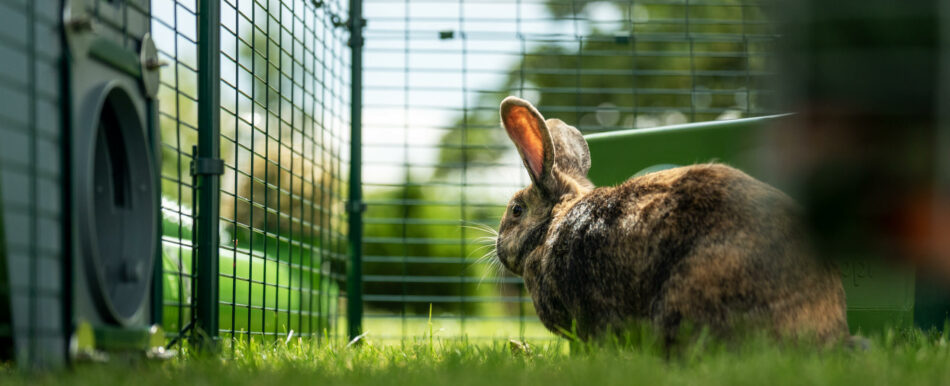
Guinea Pigs
Guinea pigs are loveable pets with big personalities. They’re adorable, vocal, and fairly easy going, making them ideal pets for owners of all ages — so long as an adult is the primary cavy caregiver. But their appearance and vocalizations have led to some common misconceptions. Here are popular myths about cavies, and what prompted such beliefs.
Myth: guinea pigs don’t need much space
Fact: cavies must live in pairs, and need plenty of space
Don’t let their compact size fool you — guinea pigs need plenty of space. They also need to be kept in pairs, as they form strong social bonds between each other. Always aim to provide as much space as possible with guinea pig runs and playpens.
Guinea pig hutches should be large enough to accommodate two cavies comfortably, and have an attached exercise area. Not only will cooped up cavies become bored, but guinea pigs are prone to being overweight, so exercise is essential. Plus, if you give your guinea pigs enough room, they’ll likely reward you with their trademark “popcorning” move.
Myth: guinea pigs are related to pigs
Fact: they are members of the rodent family
The exact origin of the name “guinea pig” isn’t clear, as they are neither from New Guinea, nor are they pigs. They originated from Peru, and are members of the rodent family. There are various theories as to how they got the first part of their name — from British currency to the trade ship route taken when importing them to other countries. The “pig” portion of their name comes from the vocalizations they make. Guinea pigs are also called “cavies” because the Latin name for them is Cavia porcellus, or “cavy” for short.
As members of the rodent family, they share some similarities with their distant cousins, mice, rats, and even capybaras, the world’s largest rodents. Guinea pigs have incisors (front teeth) that grow continuously throughout their lives, and round eyes on the sides of their head. They lack a noticable tail, making them appear more like large hamsters or tiny capybaras.
Myth: guinea pigs have short lifespans
Fact: they can live up to 8 years with proper care
Rodents generally have short lifespans, but guinea pigs have life expectancies similar to those of rabbits — usually around 6-8 years. In contrast to domesticated guinea pigs, wild cavies, or “cuy” as they’re called in Peru, only have a life expectancy of 1-4 years. But in order to live a long, full life, guinea pigs need the right nutrition.
Guinea pigs can’t manufacture their own vitamin C, so it must be supplemented in their diet. Most commercial guinea pig feed is fortified with vitamin C, but you can supplement their intake with fresh foods like bell pepper or strawberry tops, or with fortified guinea pig treats. Be sure to treat your piggies sparingly, as they can become obese easily.
A myth about rabbits and guinea pigs
Myth: rabbits and guinea pigs can be kept together
Fact: this is true — to an extent
Rabbits and guinea pigs can be kept together, but only with experienced owners and under certain conditions. To keep rabbits and guinea pigs together, the following adjustments and practices must be adhered to:
- Guinea pigs need vitamin C in their diet, while rabbits can produce their own and may become ill if they live on a guinea pig diet. Rabbits also eat more and faster than guinea pigs, meaning cavies might miss out on meals. Always feed rabbits and guinea pigs separately.
- Rabbits and guinea pigs don’t speak the same language, so recognizing the body language of each is crucial to know when one species is stressed or is feeling threatened.
- All animals kept together should be spayed and neutered, but this is especially important when keeping different species together. Intact male rabbits especially can cause serious harm to guinea pigs trying to dominate or mount them.
Keeping these two species together is possible, if you have adequate space and separate feeding areas for each. Pay special attention to their personalities and assess whether separation is needed at any point in time.
Omlet and your rabbits and guinea pigs
No matter which species you keep, our rabbit and guinea pig hutches have been designed to support the needs and preferences of both bunnies and cavies. With customizable rabbit and guinea pig tunnels and outdoor pet runs, you can simulate their natural environment to help them get in touch with their innate behaviors. When you appeal to their wild side, you’ll be rewarded with healthy, happy rabbits and guinea pigs that will never cease to amaze and inspire you.


This entry was posted in Guinea Pigs
Keeping your rabbit or guinea pig cool in the hot weather is something that all small pet owners have on their minds this time of the year. Summer is a wonderful time to spend with your rabbits and guinea pigs, but the rising temperatures can cause stress — for you and your pets. Here are some tips and tricks to keep your rabbits and guinea pigs cool when temperatures soar.
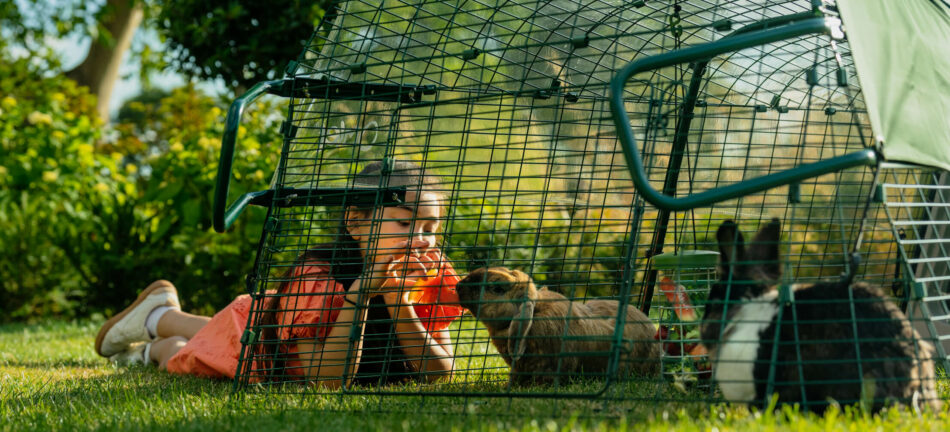
How hot is too hot?
First, it’s important to know when the temperature is simply too dangerous for your rabbits and guinea pigs to be outdoors. The answer of how hot is too hot is subjective to several factors, like:
- Your rabbit or guinea pig’s age and breed
- The ambient temperature vs “real feel” temperature (factoring in humidity)
- The amount of shade available
- How long the temperature will be elevated
As a general rule, you should watch for signs of discomfort from the heat in your rabbits and guinea pigs in temperatures above 85°F. Signs of heat stress in rabbits and guinea pigs include:
- Rapid or shallow breathing
- Open mouth breathing (panting)
- Drooling
- Lethargy
If left untreated, heat stress can quickly progress into heatstroke. Once your rabbit or guinea pig experiences heatstroke, there may be irreparable damage to their internal organs. Signs of heatstroke include those of heat stress, in addition to loss of consciousness or convulsions. If you think your rabbit or guinea pig is suffering from heatstroke, call your veterinarian right away.
How to keep your rabbits and guinea pigs cool
Thankfully, there are several ways to help keep your rabbits and guinea pigs cool in the summertime heat. These rabbit and guinea pig summer safety measures will help protect your pets from the heat, and allow them to spend more time outdoors.
An insulated hutch
Insulated rabbit and guinea pig hutches are the first line of defense against the heat. The Eglu Go Rabbit and Guinea Pig Hutch is twin-wall insulated with vents to provide airflow — which helps keep the hutch cooler than the ambient temperature. Choose a shady spot for your pets’ hutch to help it stay even cooler. When the temperatures really climb, add frozen water bottles inside of the hutch. Your pets will lay on them to cool off, and it will help to bring the interior temperature down even further.
Provide plenty of shade
Your rabbits and guinea pigs’ run should be shady to keep harmful UV rays and blistering heat off of your pets. Solid outdoor run covers keep the sun out, so that your rabbits and guinea pigs can cool down. Place water in the shaded areas to prevent algae growth, and to keep the temperature cooler. And, as with the hutch, add frozen water bottles around your pets’ shaded run to provide extra cooling relief.
Offer cooling hors d’oeuvres
Preparing frozen treats for your rabbits and guinea pigs can go a long way in keeping them cool. Here are some ideas for rabbit and guinea pig-friendly frozen treats:
- Fruit like bananas or strawberries
- Vegetables like green beans, corn, spinach, or broccoli
- Homemade frozen molds or popsicles (with an applewood chew for a stick, or no stick) made from blended fruits and veggies
Add the frozen treats to a Caddi Rabbit and Guinea Pig Treat Holder to keep them fresh for longer, and hang it in a shady part of their run. You can also add ice cubes to your rabbits and guinea pigs’ water bottle to keep it at a palatable temperature.
There are ther refreshing treats that will help your rabbits and guinea pigs stay cool. These aren’t frozen, but they’ll help hydrate your pet, and when kept in the fridge, still provide a cooling effect.
- Apple slices
- Berries
- Lettuces
- Watermelon
Other heat-hampering techniques
There are a few other supplemental methods you can use to help beat the heat. Some of these include:
- Use a patio misting system around the top perimeter of your rabbits or guinea pigs’ run. Turn it on, or have an irrigation timer set for it to be on during the hottest part of the day.
- Install a large fan just outside of the run, or in the top corner of a rabbit or guinea pig walk in run. Make sure that your pets can’t reach any power cords or moving parts of the fan.
Use a combination of both of these for the strongest effect.
What to do when it’s too hot
Depending on where you live, your rabbit or guinea pig’s age and breed, and overall health condition, there may be times where staying outside is just too dangerous. These conditions are most likely to occur during a heatwave, or in areas that experience high humidity alongside soaring summer temperatures.
If you need to move your rabbit or guinea pig to cooler temperatures, try to keep them outdoors if possible. A well ventilated garage, barn, or shed may be enough to keep their setup at a more comfortable temperature.
When shadier or cooler options just aren’t possible, you will need to bring your rabbits or guinea pigs inside. This shouldn’t be done lightly, as rabbits and guinea pigs that live outdoors year round are accustomed to being in fluctuating temperatures. Bringing them into a stable environment will acclimate them to this type of temperature and they will need to remain indoors until the outside temperature is consistently lower.
It’s common for guinea pigs to be housed indoors, and placed outside for playtime. For these pets, outside visits should be limited to early morning and late evening hours during the summer to avoid the hottest part of the day. This is also true for rabbits housed indoors.
Omlet and your small pets
Summer isn’t without its challenges, but that doesn’t mean you shouldn’t be able to enjoy it with your pets. With our rabbit and guinea pig hutches, large outdoor rabbit and guinea pig runs, and outdoor run covers, you can provide plenty of shaded support for your pets throughout the summer. With an Omlet rabbit or guinea pig setup, you can enjoy a frozen treat together with your rabbits or guinea pigs, and rest easy knowing they’re being supported all summer long.
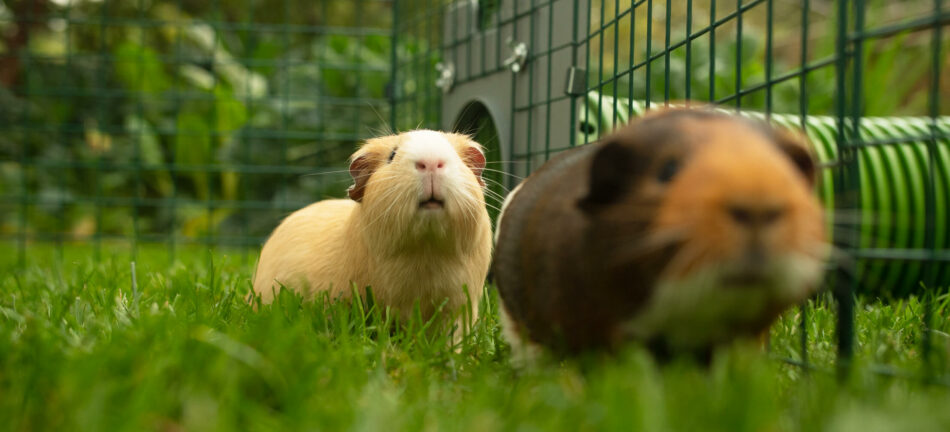

This entry was posted in Guinea Pigs
Looking for some inspiration for playtime with your small pets? There are several games you can play with your rabbits and guinea pigs that will be to the delight of everyone involved. From mazes to hide-and-seek, here are some pastimes that are sure to please your pets the next time you play.

The importance of play
Playing with your rabbits and guinea pigs builds their trust and confidence, which in turn helps you build a more meaningful and lasting bond with them. It’s amazing to see shy or timid pets come out of their metaphorical shells through playing with their humans. Being more active is good for their minds and bodies, and is one of the best ways to encourage your small pet to be more outgoing and physically fit. Through dedicated playtime, you’ll be able to forge an unbreakable bond between you and your rabbits or guinea pigs.
It’s also important to remember that rabbits and guinea pigs are prey animals by nature, so surprises, sudden movements, or loud noises can startle them easily. All of the games that you play with your small pets should be in a calm atmosphere, and with lots of treats to offer as tokens of encouragement and as rewards for their efforts.
Species-specific
Rabbits and guinea pigs differ in size and stature, so they each have their own set of skills that can be tapped into during play. For example, rabbits have long, powerful legs, so jumping over the sides of a homemade maze to fast-forward to the treat at the end is entirely within their realm of possibility. For the following activities, we will offer suggestions to modify each game based on the size and species of your pet.
Prepare a place to play
The best place to play with your rabbits and guinea pigs is in a safe and enclosed space. Outdoor rabbit and guinea pig runs are perfect for spending time with your pets during playtime. The enclosed space will keep them contained and comfortable, and gives you plenty of space to set up your games. Alternative play places are safe spaces inside your home — just make sure that the room you’re playing with your pets in is rabbit and guinea pig-proof.
Bowling
This game is more fitting for bunnies, but some guinea pigs may delight in barrelling objects over. Set up small bowling pins, like indoor sets designed for toddlers, and let your bunnies nose-boop them over. Reward your pets’ efforts with a treat before setting the pins back up for the next round.
Guinea pig modification: in relation to guinea pigs, even toy bowling pins may seem tall and intimidating — try setting up empty toilet paper tubes instead.
Magic cups
Show your rabbits or guinea pigs that you’re hiding a treat under an overturned plastic cup. Add one or two more overturned cups with nothing under them, then slide them around before allowing your pet to sniff out the hidden treat. Fresh herbs or other fragrant treats are perfect for this game.
Fetch
Think fetch is just for dogs? Think again — some rabbits and guinea pigs enjoy carrying small objects in their mouths. Try tossing small toys like balls, applewood chews, or pieces of cardboard for this game. To start out, toss the object just a few inches in front of your rabbit or guinea pig. If they pick it up, praise them, and offer a treat. Once they’re consistently picking up their toy, toss it farther out each time, and encourage them to bring it back to you.
Hide and seek
Rabbits and guinea pigs are curious by nature, so enticing them with some mystery will pique their interest. Lay on the floor and place your face in your hands. Your rabbit or guinea pig will come to investigate. Be careful not to startle your pet as you emerge, and be sure to offer them a treat for their cleverness.
Rabbit modification: hide under a soft blanket and call your rabbit. Bunnies love to burrow, so your rabbit will be thrilled at the prospect of digging in order to find you.
Maze running
Create mazes from cardboard boxes, building blocks, or other household objects with a treat placed at the end. Make sure that mazes are always placed at ground level, and that there are no small gaps or spaces for your pets’ feet to get caught in.
Rabbit modification: construct a maze from Zippi Rabbit Tunnels for the ultimate, reusable maze that your rabbits won’t hop out of.
Omlet and your rabbits and guinea pigs
From the rabbit or guinea pig hutch to outdoor runs and playpens, we’ve worked to create the perfect atmosphere for owners to spend quality time with their small pets. Design your own playground with Zippi Rabbit and Guinea Pig Tunnels, and add rabbit and guinea pig platforms to help your pets meet you on a whole new level. With Omlet, playtime isn’t just possible — it’s the pinnacle of quality time spent with your rabbits and guinea pigs.
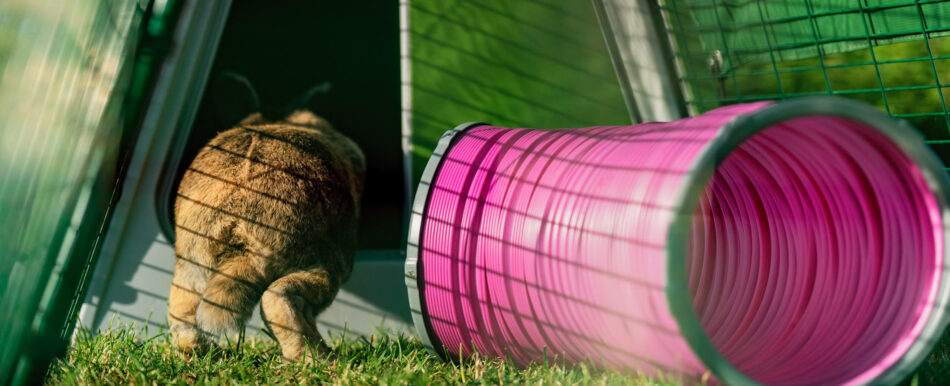

This entry was posted in Guinea Pigs
Exercise for rabbits and guinea pigs is important for their overall wellbeing, but it’s also a unique opportunity for you to bond and play with them. From playtime to training sessions, there are several ways to spend quality time with your rabbits and guinea pigs while benefiting their physical and mental health. Discover how much exercise your pets need, how to keep them fit, and how to build a bond through boredom busting activities with your rabbits and cavies.
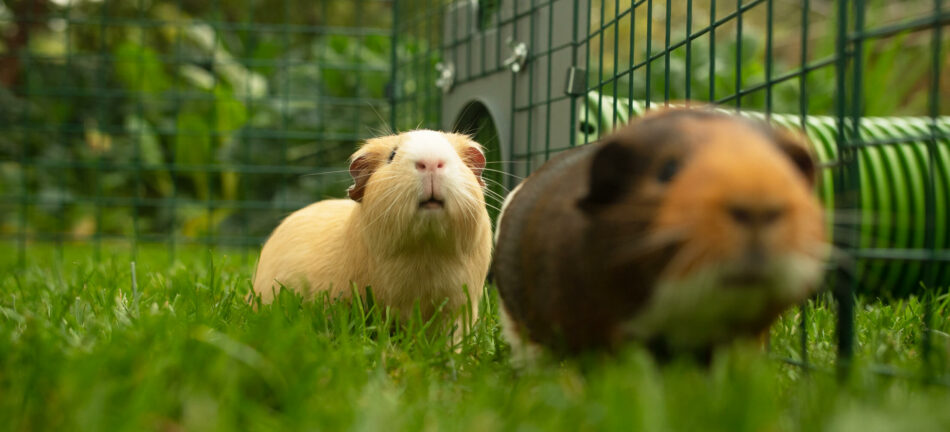
How much exercise do rabbits and guinea pigs need?
Rabbits and guinea pigs need to be able to exercise on their own, as well as doing activities with their owners. The amount of exercise needed for each pet varies and is dependent upon their genetics, diet, and environment. This means that these pets need spacious outdoor rabbit runs or guinea pig playpens to ensure they have ample space to run, hop, stretch, and explore.
Wild rabbits and guinea pigs are constantly on the move for their survival. This continuous need to move keeps them fit and spry — which are traits not always seen in their domesticated counterparts. While our backyard rabbits and guinea pigs may be distantly related to their ever-moving ancestors, their body compositions are still very similar. All rabbits have long, powerful hind legs, and guinea pigs are all potato-shaped with short legs and necks.
Guinea pigs are especially prone to being overweight, which puts strain on their small legs and joints. But rabbits aren’t immune to issues caused by lack of exercise — they too can become overweight, and are also prone to boredom if they aren’t properly stimulated. Bored bunnies can become depressed or develop destructive habits. By giving bunnies and cavies plenty of outdoor space, you’ll help them get enough exercise to keep them healthy and happy.
Encouraging your rabbits and guinea pigs to exercise
Fostering your pets’ natural behaviors is one of the best ways to encourage them to exercise. Because of their anatomy and natural instincts, rabbits need large, outdoor spaces to fulfill their need to run, burrow, and scratch. Zippi Rabbit Tunnels simulate burrows in the wild that rabbits run through, which will encourage your bunnies to explore and play. And while guinea pigs might not dig their own tunnels in the wild, they will happily use burrows dug by other animals — or in the case of domesticated guinea pigs, those provided by humans.
Guinea pigs can’t stand on their hind legs like rabbits can, so they appreciate a higher vantage point from which to view their world. Zippi Guinea Pig Platforms offer your cavies an elevated place to explore, and a shady, secluded space to hide beneath. The attached ramps encourage your guinea pigs to carry their weight at an incline, which strengthens their muscles and helps them maintain their figure.
Exercises you can do with your rabbits and guinea pigs
There are several ways to interact with your rabbits or guinea pigs while encouraging them to exercise. Some ideas include:
These are all fun ways to keep your pets fit both physically and mentally, while also providing you with a unique opportunity to build trust and confidence with them. Aim to incorporate half an hour of playtime with your bunnies and cavies once a day to help keep your pets bodies and minds stimulated. Playing with them doesn’t have to be robust, so any amount of interaction or movement that they would otherwise not be experiencing will build both a confident mind and strong muscles.
Exercises to avoid with your rabbits and guinea pigs
There is some equipment marketed for rabbits and guinea pigs that should be avoided, and some activities they shouldn’t participate in. These include:
- Exercise wheels or balls (similar to those for hamsters) marketed for rabbits or guinea pigs
- Leashes and harnesses
- Walks around your neighborhood
While it might be tempting to take your rabbits or guinea pigs for walks on a harness, the vast majority of small pets find harnesses uncomfortable and alarming, so it’s best to play with your bunnies and cavies within the safety of playpens designed for them, or in a pet-proof area of your home. Rabbits and guinea pigs are prey animals, and as such can startle and bolt easily with sudden sights and sounds — the strain from them spooking on a harness can cause severe damage to their necks, backs, and legs.
Omlet and your rabbits and guinea pigs
From guinea pig playpens and outdoor rabbit runs, we’ve created safe and smart enclosures that allow your pets the freedom to move and explore. These spacious options also make it possible for you to join them in their endeavors — putting you front and center in their lives. Watch your rabbits and guinea pigs explore through Zippi Tunnels, climb and meet you face-to-face with Zippi Platforms, and witness them experiencing the joy of fresh grass with mobile rabbit and guinea pig hutches. You, your pet, and Omlet are a winning combination for years of health and happiness to come.


This entry was posted in Guinea Pigs
Spending time with your rabbits or guinea pigs is a great way to grow your bond with them, especially when there are toys involved. DIY toys for rabbits and guinea pigs are easy to make with materials that are probably already in your home. And these toys aren’t just for your pets — you’ll find that watching and interacting with your rabbits or guinea pigs through toys is both engaging and entertaining. Discover how making some of your rabbits and guinea pigs toys can be fun and rewarding.
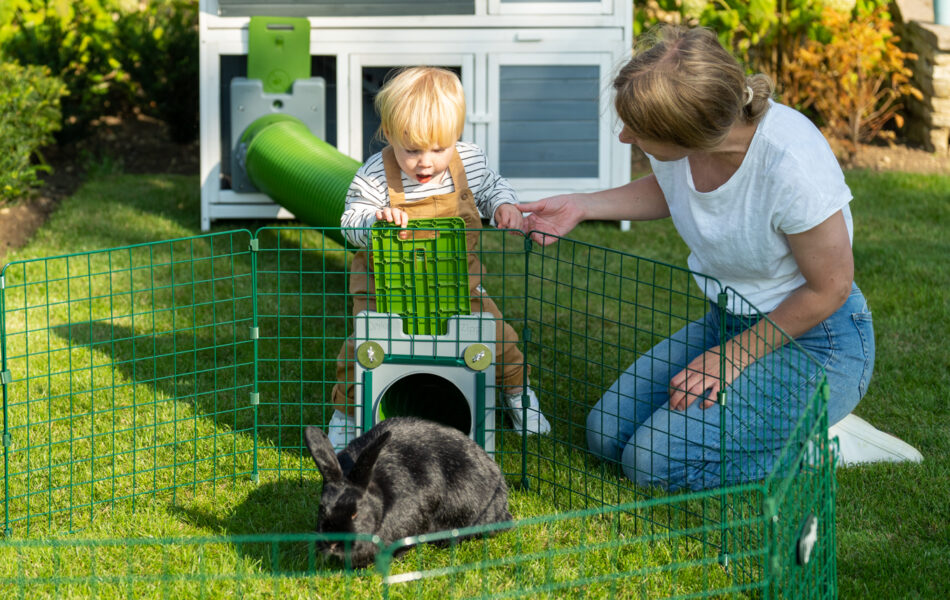
Why do rabbits and guinea pigs need toys?
First, it’s important to understand why rabbits and guinea pigs need toys. Think back to your childhood — you likely played with toys as a means of entertainment, but also to aid in the development and growth of your cognitive skills. The same is true for rabbits and guinea pigs.
Rabbits and guinea pigs are able to keep themselves active and entertained with toys, as well as grow their critical thinking and problem solving skills. These pets may be small, but they’re smart and enjoy objects to chew, toss, chase, or cuddle up with. There are several types of toys for rabbits and guinea pigs that can be purchased, but there are many that you can make at home.
How to play with your rabbits and guinea pigs
Playtimes are some of the best times with your rabbits and guinea pigs. Owners that play with their pets get to experience their individual personalities, and build a bond with them that lasts a lifetime. Through play, your pets will learn to trust you, and you’ll be able to identify their unique body language and needs.
Start by sitting on the floor or the ground with your rabbits or guinea pigs. Offering treats will help entice them to approach you if they are not already comfortable doing so. Introduce new toys one at a time so your pets aren’t overwhelmed. Show them their toy, maybe offering some movement if your pet is comfortable with it. Hang or place the toy in front of your pet, and watch them explore this new offering.
Some rabbits and guinea pigs can be taught to fetch small toys, while some are more interested in the aspect of chasing. Play around with different ways of interacting with your pets, like with Zippi Rabbit and Guinea Pig platforms to help you both see eye-to-eye.
Types of DIY toys for rabbits and guinea pigs
The most common types of toys for rabbits and guinea pigs include:
- Chews
- Activity toys
- Tunnels
- Forage boxes
- Hideouts
You can make your own versions of many of these toys using household objects, or with a short trip to your local hardware store. It’s important to remember to choose non-toxic materials for your pets’ toys. Never use treated lumber or paint for your rabbits’ or guinea pigs’ toys, and make sure that any cardboard or fabric is removed if your pets begin to nibble on them. And, it’s always a good idea to supervise your pets while they’re playing with their toys — especially if they are inclined or able to eat them.
DIY rabbit and guinea pig chews
Most rabbit and guinea pig chews are made from apple wood or compressed timothy hay, or a combination of the two. There aren’t many substitutes for apple wood chews for rabbits and guinea pigs, as they are the safest variety. But, by purchasing bulk apple wood sticks and timothy hay, you can craft your own chew toys by wrapping the sticks in strands of hay. Cut them to various lengths, and create different shapes for variety. Sisal rope can also be used to wrap apple chews and hay together — just remember to remove the toy as soon as the rope becomes frayed or gnawed.
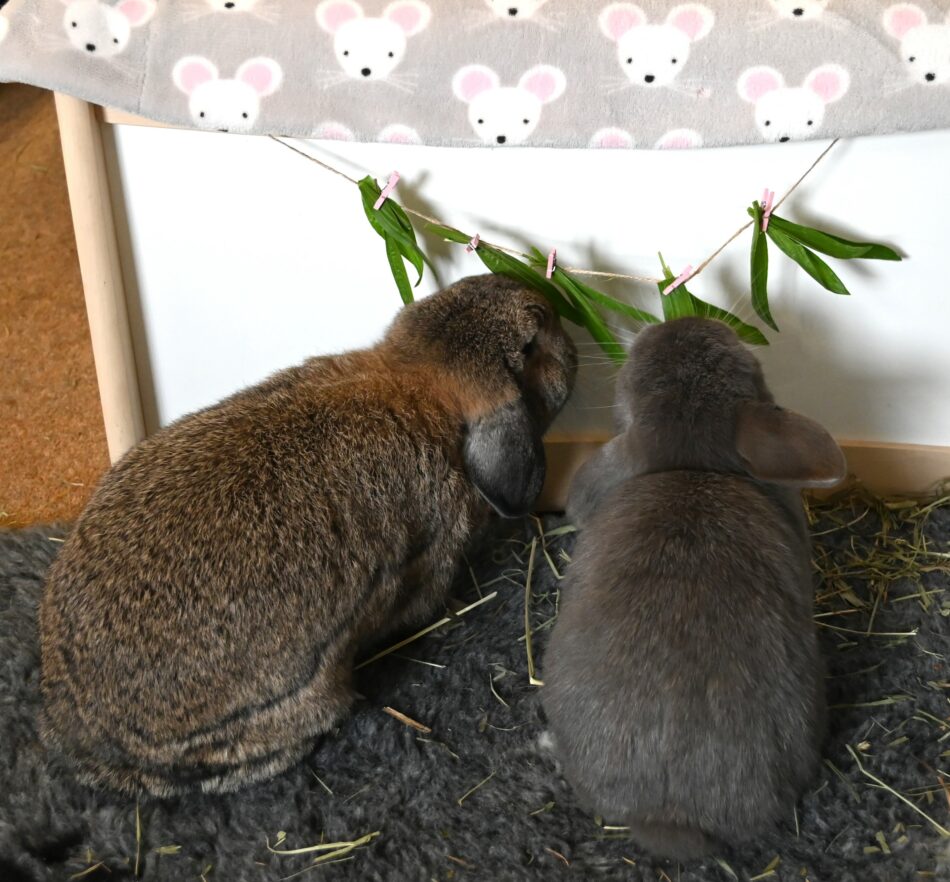
DIY rabbit and guinea pig activity toys
Activity toys are those that hang from your rabbit and guinea pig run. They’re designed to encourage your rabbits and guinea pigs to stretch, nudge, or tug. Most of these toys are made from apple wood and sisal rope, which are safe options for your pet. Experiment by making spiral or branch shapes, or by threading alternating pieces of apple wood with other edible treats like rabbit and guinea pig-safe fruit or veggies.
You can also hang a Caddi rabbit and guinea pig treat holder in their run to encourage the same activity. The Caddi reduces waste, and has lots of room for your pets’ favorite treats.
DIY rabbit and guinea pig tunnels
Rabbit and guinea pig play tunnels that are made for small pets will hold up better than DIY alternatives. Some owners make tunnels from drainage tubing, but the small holes designed to release water pose a risk to your pets’ feet. A Zippi Rabbit and Guinea Pig Tunnel System is the best investment when it comes to fostering natural burrowing behaviors in both pets. The safest way to create temporary tunnels for your rabbits and guinea pigs in the meantime is to use boxes connected end-to-end.
DIY rabbit and guinea pig forage boxes
A shallow storage tote or livestock feed bin makes an excellent base for a forage box for your rabbits and guinea pigs. Pour 1-2 inches of sand or top soil into the container, or add scraps of recycled cardboard or paper to create a substrate for your pets to dig through. Rabbits in particular will appreciate the opportunity to dig in soil. Once you’ve added a layer of substrate, toss small toys, chews or treats into the box and watch your pet forage for their findings.
DIY rabbit and guinea pig hideouts
There are several ways to create hideouts for your rabbits and guinea pigs. As prey animals, they both appreciate the opportunity to hide when they’re tired, overwhelmed, or during games of chase with each other. Rabbit and Guinea Pig Shelters are specially designed to create a safe haven for your small pets, and are the best option to be kept with their rabbit or guinea pig hutch and run. But, short play sessions, or additional options can be created with cardboard boxes, overturned plastic plant containers with an entrance cut into them, or with other creative alternatives. Just remember not to use treated materials, and be aware that DIY options are not weatherproof, and should not serve as a substitute for their hutch.
Omlet and your pets
From rabbit and guinea pig hutches, to outdoor rabbit and guinea pig runs , discover how your pets encounter their world when you’re able to take an active role in it. Explore with them, encourage them, and most of all, enjoy them on a daily basis when you have rabbit and guinea pig products that have been designed to bring you closer than ever.


This entry was posted in Guinea Pigs
Thinking about adding a small pet to your family? Despite having different needs, rabbits and guinea pigs require many of the same accommodations, so whichever you’re considering adding to your family, your shopping list will look similar. From hutches and runs, to play and feed, we’ve got the ultimate rabbit and guinea pig checklist for you to tick off before you bring your fluffy new friends home.
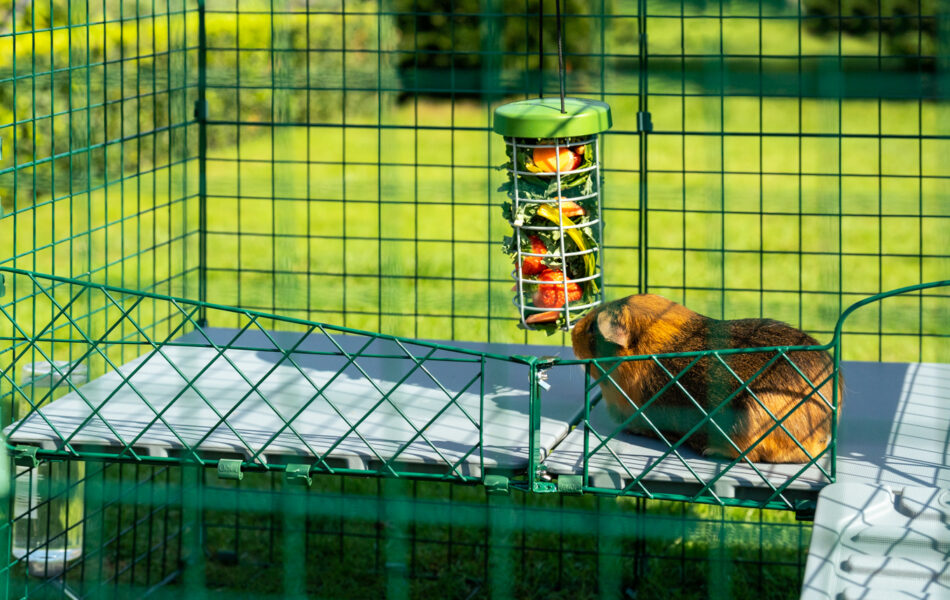
Caring for rabbits and guinea pigs
Rabbits and guinea pigs both make wonderfully rewarding family pets. They can be housed indoors or outdoors in suitable climates; either way they need plenty of room to roam and certain equipment to stay safe, happy and healthy. With the appropriate setup and care, rabbits and guinea pigs can live up to 8-10 years.
Rabbits and guinea pigs have different nutritional needs and communication methods, so should be kept separately. They’re both social animals however, and need the companionship of their own kind. So, when planning your pets’ future home, make sure you can provide room and care for at least two of either.
Hutches
Traditionally, rabbit and guinea pig hutches have been made of wood, but this poses a few problems. Both rabbits and guinea pigs have teeth that grow continuously. They need to gnaw almost constantly in order to keep their incisors from over growing, which leads to serious health problems. Wooden hutches are tempting to chew on, and treated lumber can be toxic to pets. They’re also drafty, inadequate in more extreme weather, and absorb moisture, ammonia and odors, so can become unhygienic and need replacing in no time at all.
Eglu Go Rabbit Hutches and Eglu Go Guinea Pig Hutches are designed to give your small pets the safety and comfort they need and deserve. They are both also designed to be used in conjunction with fixed, steel mesh runs, giving your rabbits or guinea pigs free access to an outdoor space (more on this below.)
- Made of pet-safe, strong, durable plastic
- Twin insulated for optimal internal temperatures
- Draft-free ventilation
- Easy to clean in a matter of minutes
- Predator proof design
- Built to last a lifetime
Starting out with a durable, easy clean rabbit or guinea pig hutch is an investment you will soon recoup, which will set you and your pets up for success from the first day.
Bedding
The bedding you use inside of your rabbits’ or guinea pigs’ hutch should be natural and absorbent. Typical bedding options include:
- Pine shavings or pellets
- Aspen shavings
- Recycled paper (this resembles loose cotton)
- Straw
Breeds of rabbits with long hair like Lionheads or Angoras need recycled paper or pine pellets as bedding – straw and shavings will get tangled in their coats. Similarly, breeds of guinea pigs with long hair like Peruvians or Shelties should not be kept on shavings or straw bedding.
Outdoor space
Rabbits and guinea pigs need plenty of space outside their hutch to stretch their legs and explore, which they should ideally have constant, secure access to. Rabbits in particular have lots of energy, so a spacious outdoor rabbit run is essential to helping them stay healthy and happy.
If you’re short on outdoor space, the Omlet Zippi Tunnel System is a great way to recreate their natural environment and let them zoom when the mood takes them, as it lets you connect their hutch to additional enclosures in different areas, as a burrow would. Guinea pigs also need an outdoor guinea pig run to stay fit and can also benefit from a tunnel system, as they can be prone to obesity and boredom if they don’t have enough space to exercise.
Omlet’s rabbit and guinea pig runs have attached floor panels to prevent digging out, which is an issue in particular with female rabbits, but is also necessary to prevent predators digging in.
Constructed of weatherproof, heavy-duty steel weld mesh, Omlet runs have a modular design that lets you expand your run when you like, making them a future proof choice.
Enriching their area
Part of the joy of having rabbits or guinea pigs is watching them play. The best rabbit and guinea pig toys are those that encourage their natural behaviors. Rabbit and guinea pig run accessories, like shelters, play tunnels and platforms make perfect places for your pets to stretch their legs, find a shady spot for a snooze, or just hunker down for some quiet time. Since both rabbits and guinea pigs are prey animals, they’re naturally nervous and always on high-alert for potential predators. Shelters and tunnels they can retreat into quickly if they perceive danger give them a sense of security, so placing these throughout the run will help your rabbits or guinea pigs feel much more at ease.
Food
Both rabbits and guinea pigs should be fed high quality pellets as per the instructions on the pack. However, unlike rabbits, guinea pigs can’t manufacture their own vitamin C, so commercially available guinea pig pellets should be fortified with this essential nutrient. Their different dietary needs are one of the main reasons rabbits and guinea pigs should be kept separately.
An essential part of their wellbeing is plenty of timothy hay, which both rabbits and guinea pigs need free-choice access to around the clock. This keeps their digestive system working as it should, but also helps keep their teeth trimmed. Timothy hay won’t cause rabbits or guinea pigs to become overweight, so it’s safe (and necessary) for it to be available at all times.
Both bunnies and cavies will most likely enjoy the odd fresh crunchy treat. Leafy greens, chunks of raw broccoli or cabbage, fresh herbs and small amounts of some fruits will have them hopping over for a nibble. Keep these treats off the ground with a Caddi Rabbit and Guinea Pig Treat Holder to keep them fresher for longer and discourage pests.
Omlet and your rabbits and guinea pigs
Keeping rabbits and guinea pigs is a rewarding experience for all ages, but despite their diminutive size, these cuties need daily care and attention. Our Eglu Go Rabbit and Guinea Pig Hutches are designed to make providing your small pets with a hygienic, comfortable home a breeze. With cleaning done and dusted in a matter of minutes, you can spend your time enjoying their quirky characters, sociable natures and natural curiosity.
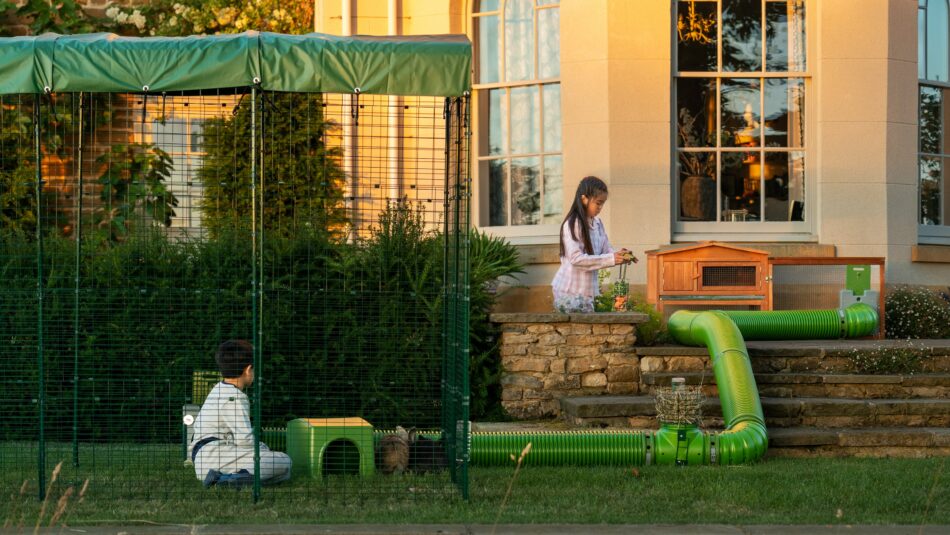

This entry was posted in Guinea Pigs
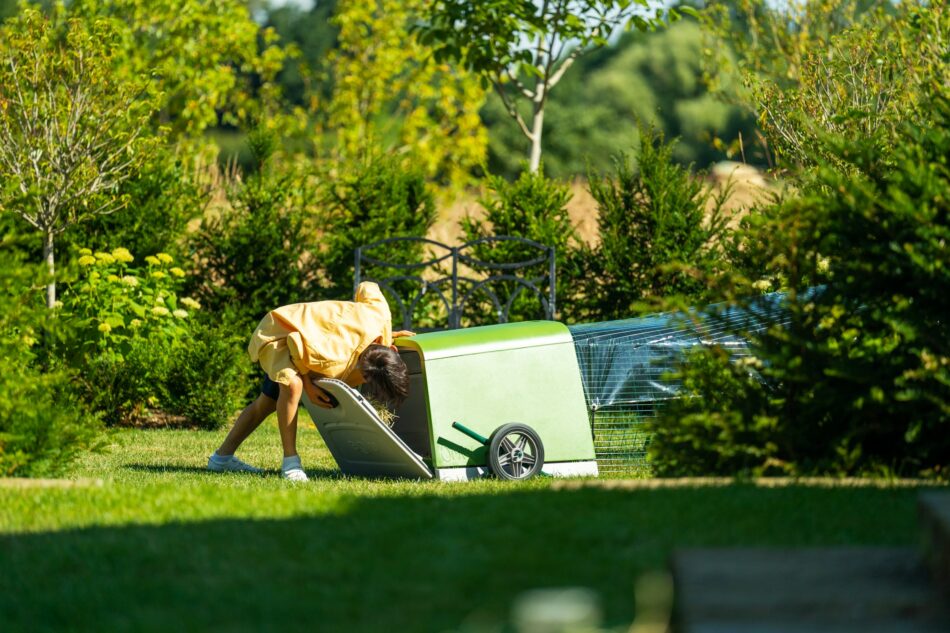
New guinea pig parents often find themselves wondering why their piggies hide. Are they scared? Shy? Stressed out? There are many reasons why cavies seek undercover solace — most of which stem from natural behaviors instead of external stressors. So why do guinea pigs hide? We’ll explore the reasons why guinea pigs hide, so that you can gain a better understanding of this innate behavior.
Danger ahead
Guinea pigs are prey animals, so they’re on constant alert for potential threats. Wild guinea pigs have to keep an eye out for predators as a means of survival, but this natural behavior remains strong in domesticated cavies. Being low to the ground, everything that’s taller than themselves may be perceived as a threat — which is just about everything aside from other guinea pigs.
Cavies have eyes set high up on the sides of their heads, giving them excellent vision to spot aerial threats. They’re also very intuitive when it comes to shadows or other movement that may clue them into a potential threat looming.
Your guinea pigs’ natural response to perceived danger is to run for cover. Cavies in the wild burrow in the dens or tunnels of other animals, or hide in thickets, under rock formations, or along the forest floor. So, in captivity, your guinea pigs will seek out the nearest shelter when they are alerted to potential danger. Giving them guinea pig play tunnels is a great way to simulate these pre-made burrows.
Other family pets may create this perceived threat response from your guinea pigs. Dogs, cats, or even pet birds can send your cavies to the nearest cover. Be sure to introduce your guinea pigs to your other pets slowly and on your cavies’ level to make them more at ease, creating a positive experience from the start.
Boredom
On the flip side of being overly alert, a depressed guinea pig can hide out of sheer boredom or low spirits. If cavies don’t have company or things to keep them busy, they may become listless and retreat to the same spot day after day.
Having an interesting and engaging habitat will help prevent boredom in guinea pigs. Providing guinea pig ramps and platforms, or using a Caddi Guinea Pig Treat Holder to elevate their favorite snacks are great ways to incorporate variety and exercise into your cavies’ daily routine.
Rearranging your guinea pigs’ run routinely will stimulate their minds and bodies. Try moving their hideouts around the run, changing up their Zippi Guinea Pig Tunnel System route, and adding new toys regularly.
Adjusting to a new setting
Guinea pigs are most likely to hide when they’re in a new environment. If you’ve just welcomed a new guinea pig, don’t be surprised to see them spend the majority of their time hiding out during the first week or two. This is especially true of adopted guinea pigs that have a complicated history with humans.
Cavies crave companionship, so it’s best to obtain guinea pigs in bonded pairs. If you’re introducing new guinea pigs, be sure to do so slowly and through a barrier so that they can warm up to each other. Don’t be surprised if your previously outgoing guinea pig hides in response to a newcomer – this is natural.
Sudden movement or loud noises
Even healthy and confident guinea pigs that have been part of your family for an extended amount of time will naturally dart for cover when they encounter sudden movement or loud noises. This is completely normal and is actually a sign of good cognitive reasoning in your guinea pigs. Much like a reflex, guinea pigs will startle at unexpected sights and sounds.
Try to keep your guinea pigs in a low-traffic area of your home or yard to avoid triggering this response constantly. While it might not be possible to eradicate all causes of sudden movement or loud noises, effort should be taken to reduce your cavies’ exposure to them.
Shyness
Not all hiding behavior is rooted in natural behavior or stress – some guinea pigs are just shyer than others. This has more to do with their individual personality than their environment. As long as your shy cavy comes out to play with their companions, to eat and drink, or is seen exploring (albeit, cautiously), it’s safe to conclude that their personality is just more on the introverted side.
Shy cavies benefit most from opaque guinea pig hideouts, or even DIY “curtains” made from strips of fleece along the front of their favorite hiding place to help them feel more comfortable. Avoid using transparent hiding structures, or those with large openings for reserved guinea pigs, as these won’t be as comforting to them.
Should you be concerned by your guinea pig’s behavior?
Hiding is completely normal and natural in cavies, but there are times when extended or sudden episodes of hiding can point to a health concern. Cavies that aren’t typically shy and suddenly spend hours a day hiding, or any guinea pigs that aren’t coming out to eat or drink should be monitored closely.
A number of health concerns could cause your guinea pig to want to hide the majority of the day, but some of the most common reasons are:
- A urinary tract infection (UTI)
- Upper respiratory infection
- Gastrointestinal problems
- Neurological disorders that cause imbalance or poor vision
- Old age
If your cavies are hiding regularly and not engaging in normal activities, it’s time to contact your veterinarian.
How to get your guinea pig out of hiding
Guinea pigs that are potentially ill should not be left to hide for more than 24 hours, whereas cavies adjusting to a new home should be given a minimum of two weeks to fully acclimate. It’s always best to let your guinea pig come out of their hiding place on their own, but some situations dictate the need to move them yourself. If you need to remove your guinea pig from their hiding spot, be sure to do so safely and in the least stressful way possible.
- Close off the entrance to their hide by either closing the door (if possible) or sliding a solid object in front of it
- Gently lift the hideout or reach into their hiding spot and grasp them as you normally would to lift them – supporting their entire body in the process
- Hold your guinea pig securely against you to help them feel safe
Omlet and your guinea pigs
Our guinea pig products are designed to foster cavies’ natural instincts – hiding included. The Eglu Go Guinea Pig Hutch is the perfect piggy hideout with convenient human access if needed. And, our line of Zippi Guinea Pig Shelters, Guinea Pig Play Tunnels, and Zippi Guinea Pig Tunnel Systems offer your cavies several comfortable options to hide and hang out while encouraging physical movement and mental stimulation. At Omlet, we bring nature to your own backyard and blend it with ways to deepen the bond between you and your guinea pigs.
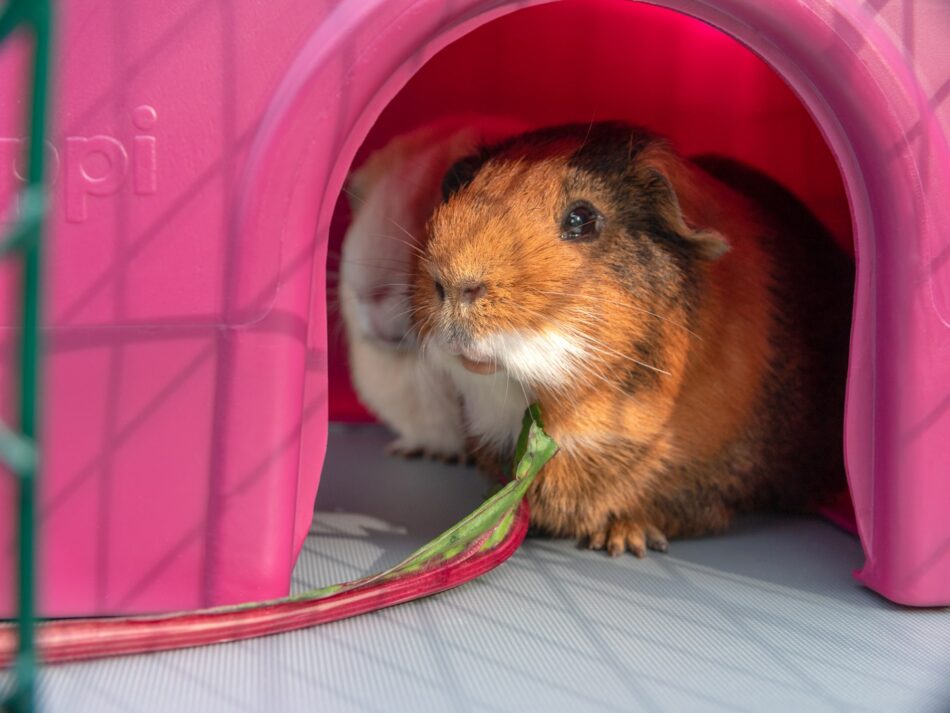

This entry was posted in Guinea Pigs
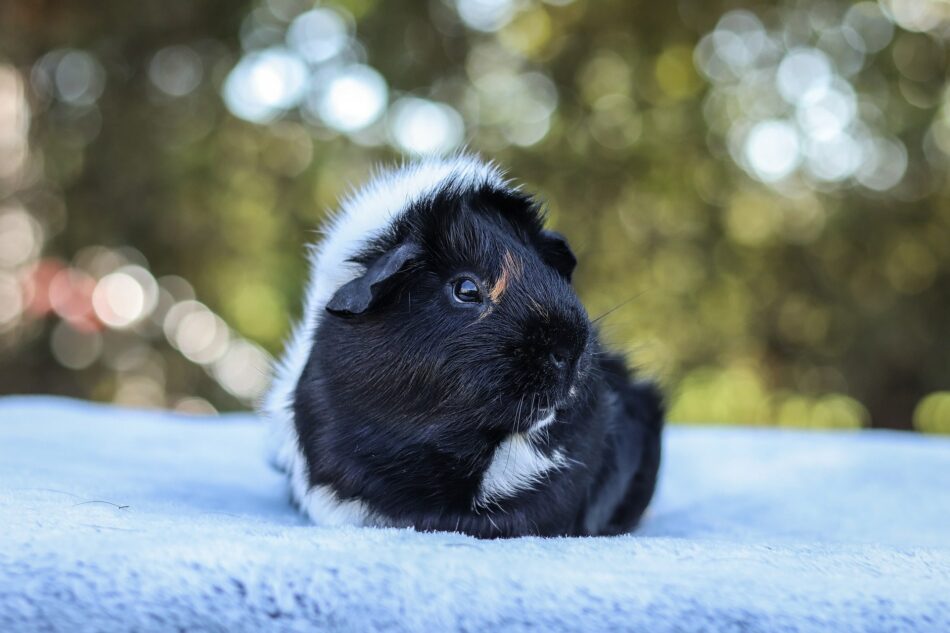
Winter wonderlands may appeal to some people and animals – but guinea pigs do not like the snow. In fact, because of their physiology and origins, snow can be dangerous for cavies. See how to protect your guinea pigs this winter from the snow, and how to help them enjoy the chilly season ahead.
Why do guinea pigs dislike the snow?
Guinea pigs trace their lineage back to wild cavies in South America. While our domesticated piggies are far removed from their wild cousins that still roam this area, their physiology hasn’t changed much. Because their native habitat is a temperate climate, guinea pigs are sensitive to extreme temperatures. The freezing temperatures that create snow, and the snow itself are both a threat to your cavies’ health and safety.
The dangers of snow to guinea pigs
Even if your guinea pigs are accustomed to living outdoors, winter precipitation poses a large threat to their safety. Here are some of the reasons why snow can harm your cavies.
Frostbite
Frozen precipitation can spell frostbite quickly for uncovered body parts. Guinea pigs have naked feet that are susceptible to frostbite if they have to stand in the snow for an extended period of time. Anything more than a few moments of contact can chill your cavies’ feet to the point of frostbite. If you suspect your guinea pig has frostbite, you should contact your veterinarian right away.
Hypothermia
While it’s not specific to the snow, hypothermia can occur quickly in cavies that are both cold and damp. Hypothermia sets in when a guinea pig’s body temperature drops below 95 degrees. Symptoms of hypothermia in guinea pigs include:
- Shivering
- Lethargy
- Pale limbs that are cool to the touch
Cavies that have gotten too cold should be brought into a warm space quickly, but caution should be taken that they aren’t warmed up too quickly to avoid sending them into shock. Wrap them up in a blanket or towel and bring them inside, while rubbing their bodies vigorously. Hypothermia is a medical emergency in guinea pigs, and you should always call your veterinarian if your cavy displays any symptoms.
Reduced access to food and water
Another winter weather struggle is keeping the path to your guinea pigs’ food free of snow, and keeping their water thawed. Frozen paths or snowy treks to get to their food with increase your cavies’ risks of contracting frostbite or hypothermia.
Feeders should be elevated to prevent snow from blowing into their feed, and water bottles should be rotated throughout the day, being replaced with warm water. You can also wrap water bottles to insulate them against the cold. Open-top containers of water can have bird bath heaters submerged in them to prevent them from freezing — but be sure that any electrical cords are out of your cavies’ reach.
Guinea pig snow safety tips
Guinea pigs can fare outside in the snow if certain conditions are met. But, if the temperatures are below freezing for an extended period of time, or if your area receives heavy snowfall, it may be best to bring your guinea pigs inside for the winter.
Proper housing
An insulated, draft-free guinea pig hutch can go a long way in keeping your cavies safe in the cold. Omlet’s Eglu Go Guinea Pig Hutch is designed for year-round use and comfort, while providing a snow-free reprieve from the elements. Use deep bedding like straw and provide fleece blankets inside of the hutch for your cavies to burrow into for extra warmth.
Add layers
Extreme weather jackets can be added to the Eglu Go Guinea Pig Hutch for an added layer of insulation. These hutch covers keep snow and ice off of the hutch, keeping the interior temperature more stable. And, with full coverage, the doors and latches of the hutch will remain accessible and frost-free.
Reinforce their run
You can keep snow out of your cavies’ run by covering the top and sides. Our guinea pig run covers are heavy-duty, and effectively keep precipitation out of the run. Choose clear covers to allow warming rays of sun in while keeping the snow out, or solid covers to give your guinea pigs the feeling of privacy when they venture out in the winter air. Or, combine both types of tarps for the best of both worlds.
Do some guinea pigs fare better than others?
The same safety measures should be taken for any breed of guinea pigs. While cavies have a variety of coats, there are no distinct advantages of a certain type or texture of fur. Longer-haired guinea pigs may be better insulated than short-haired breeds, but as long as your guinea pigs are used to living outdoors, they’ll have molted and regrown a new winter coat that’ll help insulate them against the cold. The main goal is to keep your cavies’ coats dry so that they’re able to maintain their insulating properties.
The exception to this is the Skinny Pig breed. These hairless cavies have no coats at all to protect them from extreme temperatures, and should only be kept outdoors during moderate weather.
Omlet and your guinea pigs
Guinea pigs might not like the snow, but they can enjoy their time outside this winter in an Eglu Go Guinea Pig Hutch. Keeping a close eye on your cavies during the cooler weather will help ensure they’re enjoying their time outside and prevent health conditions brought on by the snow. And, with Omlet, your guinea pigs can nestle in their insulated hutch — comfortably dreaming of the snowless days to come.


This entry was posted in Guinea Pigs

Like many other pets, guinea pigs molt twice a year. This process of shedding their old coats and putting on a fresh coat for the season is natural, and may be more noticeable in some cavies than others. Find out if the fur you’re finding in your guinea pig’s home is part of this seasonal shed, or if the condition of your cavy’s coat points to something else.
Why do guinea pigs shed?
The seasonal shedding event is called “molting,” and nearly all animals that have fur or feathers molt. Guinea pigs will typically molt twice a year: in the spring and early fall. The spring shedding session is to prepare for the warmer weather ahead, while the fall molt allows guinea pigs to grow thicker fur for the winter. As the days grow longer or shorter and the temperatures begin to fluctuate, cavies are cued to start their seasonal transformations.
Outdoor guinea pigs may exhibit a more exaggerated shedding pattern, as they will take their cue to shed from the sun and the weather. It’s not unusual to see a lot of fur in your guinea pig’s hutch or run, and as long as you don’t notice bald patches, this hair loss is perfectly normal during a molt. With this rapid shedding and regrowing of fur, it should take your cavy between 2-6 weeks to complete a molt.
Indoor guinea pigs may shed more gradually throughout the year, as they aren’t exposed to as much sunlight or changes in temperature as their outdoor counterparts. This may make it seem like indoor cavies shed constantly – which is due to a very slow molting cycle. Since they don’t feel the urgency that outdoor guinea pigs experience when growing a new coat, they will slowly shed old fur throughout the year, which results in daily shedding in small amounts.
Molting takes a lot of energy, so you may see your guinea pigs sleeping more than usual. They may also be more hesitant or less tolerant of being handled. This is due to hair follicles putting pressure on their skin, which can cause minor discomfort. You may also notice your guinea pigs scratching or rubbing their coats along their hutch or run to help rid their coats of loose hair.
Do all guinea pigs shed?
Nearly all breeds of guinea pigs shed – except hairless varieties. You can usually tell by looking at your cavy’s natural coat how much they will shed. Guinea pigs with long or dense hair will have a more dramatic shedding pattern than short-haired breeds. Breeds that will typically have the most prominent shedding include:
Skinny pigs are a breed of hairless guinea pigs that will not molt, unless they have small tufts of fur. However, since they lack natural insulation, they should be kept in a climate-controlled setting to help them keep their body temperatures regulated. Skinny pigs aren’t good candidates to be outdoor cavies – except during temperate weather.
How to care for your cavies during heavy shedding
Caring for your cavies during a molt isn’t much different from their ordinary daily routine. But, there are a few things you can do to help them feel more comfortable and to reduce your guinea pigs’ shedding.
Grooming
Brushing your guinea pig can help control shedding by ridding their coat of loose hair. Fur that has been shed from the skin can cling to the surrounding coat and create an irritating buildup of more hair and debris. Since long-haired guinea pig breeds are more susceptible to matting under normal conditions, it’s especially important to brush them regularly while they’re molting to prevent knots and mats from forming.
Grooming your guinea pig also gives you an opportunity to do a quick health check with them. While you brush your cavy, check for:
- Weight loss or gain
- Lumps or bumps
- Overgrown toenails or teeth
- Parasites in their coat
- Flaky or inflamed skin
- Discharge from their eyes, ears, or nose
Nutrition
Molting takes extra energy, so nutrition is important while your cavy is growing in a new coat. Guinea pigs should always have constant access to timothy or orchard grass hay and a hay-based pellet diet. Since cavies can’t manufacture their own vitamin c, be sure their feed is fortified with this essential nutrient – which is also essential for a healthy hair coat. This is a necessary component of your guinea pig’s diet all year round, but is especially important during a molt to grow a healthy, vibrant new coat. Providing your piggies with a vitamin c supplement in addition to their regular feed during the molting season is perfectly safe, so long as you don’t exceed levels of 100 mg/kg daily.
Fresh water should also be available at all times. If your guinea pig drinks from a crock, be sure to skim the shed hair from it daily. Water bottle nozzles may also catch loose hair that is blown around, and can clog or leak if the fur interferes with the stopper.
Environment
Keeping your guinea pig’s hutch and run clean and stress-free is essential to helping them through a molt. The Eglu Go Guinea Pig Hutch is easy to clean thoroughly in just minutes, and offers convenient access to your cavy’s food and water. The cozy interior offers solace from the outside world, as well as a comfortable place to relax during both hot and cold outdoor temperatures.
Giving your cavies extra space during heavy shedding minimizes stress and the amount of hair they may accidentally consume. An outdoor guinea pig run is a great way to let your cavies take advantage of fresh grass and sunshine, and allows for a breeze to carry the remnants of their discarded coats away.
Abnormal guinea pig shedding
Aside from the heavy shedding in spring and fall, minimal shedding is to be expected from guinea pigs throughout the year. As long as there are no visible signs of distress or illness, routine hair loss isn’t concerning. However, be on the lookout for the following changes in your cavy’s coat:
- Red or flaky skin
- Bald patches
- Fleas or other visible parasites
- Excessive scratching or biting at their coat
If you notice your guinea pig has any of these symptoms, contact your veterinarian. Do not attempt to apply home remedies to your cavy’s coat, as many products that are safe for dogs or cats (or humans) are not compatible with guinea pigs.
Omlet and your guinea pig’s shed
We’re always creating ways to keep cavies and their keepers safe and happy all year round. When you house your guinea pigs in our Eglu Go Guinea Pig Hutch and Outdoor Guinea Pig Run, you can be sure that they’re enjoying their time outside to the fullest – even during a molt. No matter the season or scenario, our guinea pig products will lend the support and comfort that your cavies crave.


This entry was posted in Guinea Pigs

Guinea pig summer safety is an important undertaking for keeping cavies healthy and happy during the warmer months. Just like us, our guinea pigs can enjoy the season as long as they’re able to stay cool, hydrated, and comfortable. Omlet makes it possible for your guinea pigs to be able to weather the warmth and enjoy summer to the fullest.
Do guinea pigs enjoy summer?
Like many pets, guinea pigs are adaptable and can enjoy the warmer weather so long as:
- Your cavies are used to being housed outdoors for several hours a day
- They have plenty of water and shade
- You’re able to check in on them every couple of hours
Guinea pigs that are housed in a climate-controlled setting may experience shock from the sudden change in temperature if they’re taken out during the heat of the day. If you plan to take your indoor-raised cavy outside, make sure to introduce them to the higher temperatures gradually, starting during the coolest part of the day.
Cavies can live outdoors year-round if they’re housed in a well-ventilated and insulated guinea pig hutch. The Eglu Go Guinea Pig Hutch is designed to keep cavies comfortable in all weather conditions. The unique twin-wall insulation helps regulate the internal temperature while deflecting external heat.
Signs your guinea pigs are too hot
Recognizing the signs of heat stress in your guinea pigs is crucial for preventing them from experiencing heat stroke. Keep a close eye on both your guinea pigs and the thermometer to make sure they aren’t getting too hot outside.
Monitor for heat stroke in guinea pigs
It should be noted that even guinea pigs housed outdoors should be monitored closely when the weather warms up. Sudden temperature spikes or prolonged temperatures above 80℉ can cause heat stress in guinea pigs, which can lead to heat stroke. Once cavies start to experience heat stroke, it’s very hard to reverse its effects. Not all guinea pigs will experience heat stress at these temperatures, but it’s important to keep a close eye on them regardless.
Heat stress vs. heat stroke in guinea pigs
Heat stress, or heat exhaustion, is the beginning stage of heat stroke. Heat stress occurs when your guinea pig’s internal temperature rises above their normal temperature of 103℉. Cavies experiencing heat stress may appear lethargic with heavier breathing than usual. Symptoms may appear suddenly, or come on gradually, but a guinea pig experiencing heat exhaustion can quickly progress to heat stroke. Any guinea pigs observed to be overheating should be brought into a cooler area until they act normally again.
Symptoms of heat stroke in guinea pigs
Once a guinea pig has progressed from heat stress to heat stroke, their symptoms can become serious quickly. Symptoms of heat stroke in guinea pigs include:
- Laying down – especially stretched out on their sides
- Heavy breathing or open-mouthed panting
- Dehydration
- Lethargy
- Seizures
If you see your cavy displaying any of these symptoms, bring them inside promptly. Refrain from cooling your guinea pig down too quickly – as this can cause their bodies to go into shock. Place them in front of a fan, and offer water if they are able to drink. Use room temperature water to cool them, never ice-cold. Place rags soaked in water on your guinea pigs to help cool them gradually, swapping them out every few minutes.
Call your veterinarian right away if your guinea pig does not perk up within a few minutes of being inside. Some effects of heat stroke are irreversible, even by a veterinarian, so time is of the essence. To err on the side of caution, even if your cavy perks up and acts normally after a while inside, you can still contact your veterinarian to discuss the next steps and if the event is expected to cause any lasting damage.
Which guinea pigs can get too hot?
Guinea pigs come in a variety of coat lengths and textures. Long-haired or thick-coated guinea pigs struggle the most in warm weather. These breeds include:
Because of their excess hair, they have a harder time feeling the cooling effects of a breeze or mist. They also require extra grooming to keep their coats in “working” condition. A guinea pig’s coat acts as natural insulation, keeping heat and cold away from their skin. If a guinea pig’s hair becomes matted down to their skin, they lose the insulating effects.
Another breed to take extra care with are Skinny Pigs, as they lack hair altogether – which means they have no built-in insulation to combat the heat. Though it may seem like they would be good candidates for warm weather, they are actually more sensitive to temperatures than their fully-furred counterparts.
3 tips for keeping guinea pigs cool in summer
Along with a ventilated and well-insulated hutch, there are other ways to help keep your guinea pigs cool during the summer months. Set up your cavies for a successful summer with these tips and tricks.
1. Create some shade
Your guinea pigs’ outdoor run is a great place to create shady places to relax during warmer weather. Zippi Guinea Pig Platforms not only give your cavies more room in their run, but also provide a shady spot to retreat to when the sun is out. Zippi Guinea Pig Shelters can be placed throughout the run to offer a hiding spot from UV rays as well. And, with guinea pig run weather covers you can create large shaded areas for your cavies to cool off in.
Add optional wheels and handles to your guinea pigs’ Eglu Go hutch to easily move them to a shadier spot in the yard. With the freedom to move with ease, you can relocate your piggies as often as the sun moves.
2. Offer frozen treats
Who doesn’t enjoy a good frozen treat on a hot summer day? Toss some guinea pig-friendly foods in the freezer to offer up during warmer weather. Fill a Caddi Guinea Pig Treat Holder with the chilled treats to reduce waste and help them last longer. The Caddi treat holder hangs easily from any Omlet run or other setup and can be adjusted to help piggies of all stature reach their frozen treats.
You can also freeze water bottles to place in the run or hutch with your cavies. Place the frozen bottles on their sides in a place where they won’t roll to prevent injuries. Offer 1-2 bottles per guinea pig, and watch them cozy up to these cooling containers.
3. Spend some time indoors
For particularly scorching temperatures, it may be best to bring your guinea pigs indoors during the heat of the day. You can create a safe space for them inside with a Zippi Guinea Pig Playpen so that they can enjoy the climate-controlled environment without getting into mischief. Guinea pigs’ ideal ambient temperatures are between 65-75°F. If you plan to put your guinea pig back outside, make sure not to keep them indoors for more than a few hours. The best time to bring them inside is during the hottest part of the day – usually around 3:00-4:00 pm until sunset. Once the sun goes down and the outdoor temperatures begin to fall, it will be safe to put your guinea pigs back in their home.
Omlet and your cavies
Keeping your cavies cool during the summer doesn’t have to be a chore. When you start out with the right setup, supplementing their well-being is much less work – leaving more time for summer fun with your guinea pigs. House your cavies in an Eglu Go Guinea Pig Hutch for year-round comfort, and add Zippi Guinea Pig Platforms for fun and shelter from the sun. Top their setup off with a Caddi Guinea Pig Treat Holder, and your guinea pigs will be ready to enjoy summers for years to come.


This entry was posted in Guinea Pigs







































